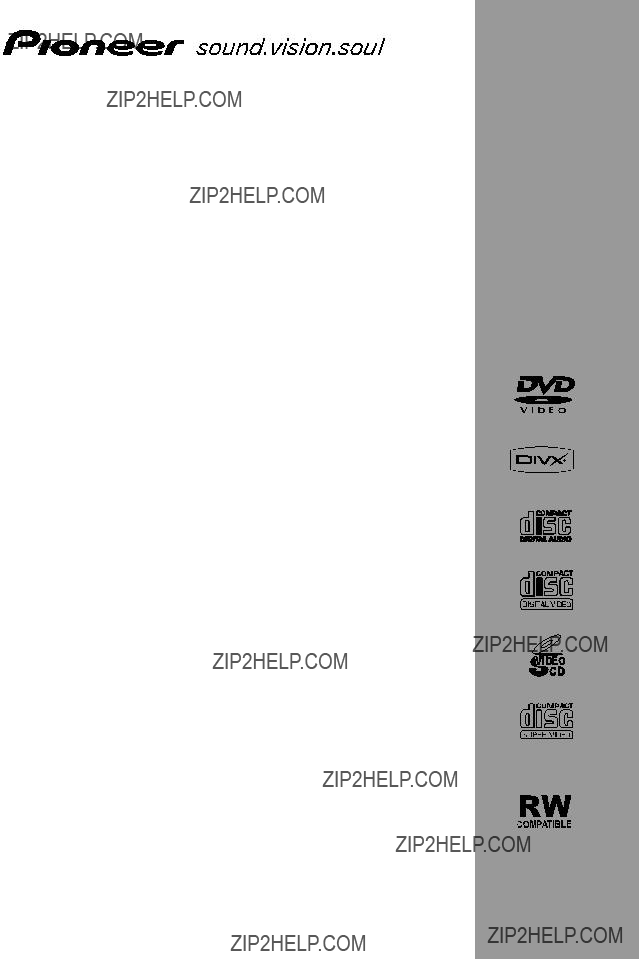


IMPORTANT
CAUTION
RISK OF ELECTRIC SHOCK
DO NOT OPEN
shock to persons.
CAUTIONAll other models
This product is a class 1 laser product, but this product contains a laser diode higher than Class 1. To ensure continued safety, do not remove any covers or attempt to gain access to the inside of the product. Refer all servicing to qualified personnel.
The following caution label appears on your unit.
Location: top of the main unit
Taiwan model
CAUTION : CLASS 3B VISIBLE AND INVISIBLE LASER
RADIATION WHEN OPEN, AVOID
EXPOSURE TO THE BEAM.
VRW2159
Location: bottom of the main unit
CLASS 1
LASER PRODUCT
WARNING
This equipment is not waterproof. To prevent a fire or shock hazard, do not place any container filed with liquid near this equipment (such as a vase or flower pot) or expose it to dripping, splashing, rain or moisture.
WARNING
Before plugging in for the first time, read the following section carefully.
The voltage of the available power supply differs according to country or region. Be sure that the power supply voltage of the area where this unit will be used meets the required voltage (e.g., 230 V or 120 V) written on the rear panel.
VENTILATION CAUTION
When installing this unit, make sure to leave space around the unit for ventilation to improve heat radiation (at least 30 cm at top, 15 cm at rear, and 15 cm at each side).
WARNING
Slots and openings in the cabinet are provided for ventilation to ensure reliable operation of the product, and to protect it from overheating. To prevent fire hazard, the openings should never be blocked or covered with items (such as newspapers,
To prevent a fire hazard, do not place any naked flame sources (such as a lighted candle) on the equipment.
Operating Environment
Operating environment temperature and humidity: +5 ??C to +35 ??C (+41 ??F to +95 ??F); less than 85 %RH (cooling vents not blocked)
Do not install this unit in a poorly ventilated area, or in locations exposed to high humidity or direct sunlight (or strong artificial light)
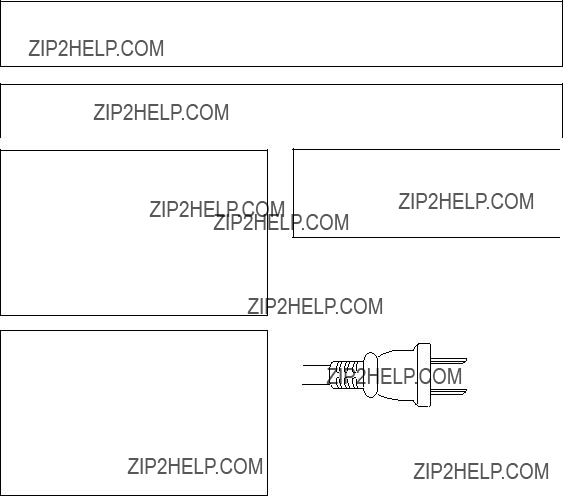
CAUTION : USE OF CONTROLS OR ADJUSTMENTS OR PERFORMANCE OF PROCEDURES OTHER THAN THOSE
SPECIFIED HEREIN MAY RESULT IN HAZARDOUS RADIATION EXPOSURE.
CAUTION : THE USE OF OPTICAL INSTRUMENTS WITH THIS PRODUCT WILL INCREASE EYE HAZARD.
Information to User
Alteration or modifications carried out without appropriate authorization may invalidate the user???s right to operate the equipment.D8-10-2_En
CAUTION
The STANDBY/ON switch on this unit will not completely shut off all power from the AC outlet. Since the power cord serves as the main disconnect device for the unit, you will need to unplug it from the AC outlet to shut down all power. Therefore, make sure the unit has been installed so that the power cord can be easily unplugged from the AC outlet in case of an accident. To avoid fire hazard, the power cord should also be unplugged from the AC outlet when left unused for a long period of time (for example, when on vacation).
If the AC plug of this unit does not match the AC outlet you want to use, the plug must be removed and appropriate one fitted. Replacement and mounting of an AC plug on the power supply cord of this unit should be performed only by qualified service personnel. If connected to an AC outlet, the
The equipment should be disconnected by removing the mains plug from the wall socket when left unused for a long period of time (for example, when on vacation).
This product is for general household purposes. Any failure due to use for other than household purposes (such as
For Taiwan exclusively
Taiwanese two pin

Thank you for buying this Pioneer product.
Please read through these operating instructions so that you will know how to operate your model properly. After you have finished reading the instructions, put them in a safe place for future reference.
Contents
Checking what???s in the box . . . . . . . . . . . . . . . 6
Loading the batteries . . . . . . . . . . . . . . . . . . . 6
Range of the remote control unit . . . . . . . . . . 7 Attaching the
Connecting the speaker terminals . . . . . . . . 10 Multichannel speaker connections . . . . . . . . 12 Hints on speaker placement. . . . . . . . . . . . 12 Connecting the radio antennas. . . . . . . . . . . 13 Connecting external antennas . . . . . . . . . . 13
Connecting to your TV. . . . . . . . . . . . . . . . . . 14
Connecting using the component video output . . . . . . . . . . . . . . . . . . . . . . . . . . . . 14
Connecting auxiliary components. . . . . . . . . 15
Connecting the power. . . . . . . . . . . . . . . . . . 15
Front panel . . . . . . . . . . . . . . . . . . . . . . . . . . 16 Display . . . . . . . . . . . . . . . . . . . . . . . . . . . . . 17 Remote control . . . . . . . . . . . . . . . . . . . . . . . 17
Using the
Playing discs . . . . . . . . . . . . . . . . . . . . . . . . 20
Basic playback controls . . . . . . . . . . . . . . . 21 Resume and Last Memory . . . . . . . . . . . . . 21
Listening to the radio . . . . . . . . . . . . . . . . . . 22
Improving FM stereo sound . . . . . . . . . . . . 22 Reducing AM reception noise . . . . . . . . . . 22
Memorizing stations . . . . . . . . . . . . . . . . . . . 23
Manually saving station presets . . . . . . . . . 23 Automatically saving station presets . . . . . 23 Listening to station presets . . . . . . . . . . . . 23 Listening to other sources . . . . . . . . . . . . . . 23
05 Setting up for surround sound
Home theater sound setup . . . . . . . . . . . . . . 24 Setting the channel levels. . . . . . . . . . . . . . 25
About the listening modes . . . . . . . . . . . . . . 26
Auto listening mode . . . . . . . . . . . . . . . . . . . 26
Listening in surround sound . . . . . . . . . . . . . 26
Using Front Surround . . . . . . . . . . . . . . . . . . 27
Using the Front Surround mode . . . . . . . . . 27 Using the Extra Power mode. . . . . . . . . . . . 27
Listening in stereo. . . . . . . . . . . . . . . . . . . . . 27
Listening with headphones . . . . . . . . . . . . . . 27
Scanning discs . . . . . . . . . . . . . . . . . . . . . . . 28
Playing in slow motion . . . . . . . . . . . . . . . . . 28 Frame advance/frame reverse . . . . . . . . . . . . 28 Playing a JPEG slideshow . . . . . . . . . . . . . . . 28 Browsing DVD or Video CD/Super VCD discs with the Disc Navigator . . . . . . . . . . . . . . . . . 29 Browsing WMA, MP3,
Using repeat play . . . . . . . . . . . . . . . . . . . . . 30 Using random play . . . . . . . . . . . . . . . . . . . . 31
Creating a program list . . . . . . . . . . . . . . . . . 31
Using the OSD . . . . . . . . . . . . . . . . . . . . . . 31
Other functions available from the program menu . . . . . . . . . . . . . . . . . . . . . . . . . . . . . 32
Using the front panel display . . . . . . . . . . . 32
Using Playlists. . . . . . . . . . . . . . . . . . . . . . . . 32
Programming playlists . . . . . . . . . . . . . . . . 32 Listening to playlists . . . . . . . . . . . . . . . . . . 33 Clearing files from a playlist . . . . . . . . . . . . 33
Searching a disc . . . . . . . . . . . . . . . . . . . . . . 33 Switching subtitles . . . . . . . . . . . . . . . . . . . . 33
Switching language/audio channels . . . . . . . 34
Zooming the screen . . . . . . . . . . . . . . . . . . . 34
Switching camera angles . . . . . . . . . . . . . . . 34 Displaying disc information. . . . . . . . . . . . . . 34
4
En

Using the USB interface . . . . . . . . . . . . . . . . 35 Basic playback controls. . . . . . . . . . . . . . . . . 35
Scanning files . . . . . . . . . . . . . . . . . . . . . . . . 36
Playing a JPEG slideshow . . . . . . . . . . . . . . . 36 Browsing files with the Navigator . . . . . . . . . 36
Singing karaoke . . . . . . . . . . . . . . . . . . . . . . 37
Changing the vocal mix . . . . . . . . . . . . . . . 37 Changing the backing track . . . . . . . . . . . . 37
Using the Sound menu . . . . . . . . . . . . . . . . . 38
Using the Sound Field Control. . . . . . . . . . . . 38 Boosting the bass level . . . . . . . . . . . . . . . . . 39
Muting the sound . . . . . . . . . . . . . . . . . . . . . 39
11 Audio Settings and Video Adjust menu
Audio Settings menu. . . . . . . . . . . . . . . . . . . 40 Audio DRC . . . . . . . . . . . . . . . . . . . . . . . . . 40 Virtual Surround . . . . . . . . . . . . . . . . . . . . . 40 Video Adjust menu . . . . . . . . . . . . . . . . . . . . 40
Using the Initial Settings menu . . . . . . . . . . . 42 Video Output settings . . . . . . . . . . . . . . . . . 42
Language settings . . . . . . . . . . . . . . . . . . . 42 Display settings . . . . . . . . . . . . . . . . . . . . . 43 Options settings . . . . . . . . . . . . . . . . . . . . . 43 Parental Lock . . . . . . . . . . . . . . . . . . . . . . . 43
Optional system settings . . . . . . . . . . . . . . . . 46 System Setup menu options in standby . . . 46 Setting the sleep timer. . . . . . . . . . . . . . . . . . 47
compatibility . . . . . . . . . . . . . . . . . . . . . . . . . 47
Disc compatibility table . . . . . . . . . . . . . . . . 48 About DVD+R/DVD+RW compatibility. . . . 48
About DivX . . . . . . . . . . . . . . . . . . . . . . . . . 48
About
About WMA . . . . . . . . . . . . . . . . . . . . . . . . 49
Using and taking care of discs. . . . . . . . . . . . 49
DVD Video regions . . . . . . . . . . . . . . . . . . . 49 Handling discs . . . . . . . . . . . . . . . . . . . . . . 50 Storing discs . . . . . . . . . . . . . . . . . . . . . . . . 50 Discs to avoid . . . . . . . . . . . . . . . . . . . . . . . 50
Installation and maintenance . . . . . . . . . . . . 50
Hints on installation . . . . . . . . . . . . . . . . . . 50
Cleaning the pickup lens. . . . . . . . . . . . . . . 50 Problems with condensation. . . . . . . . . . . . 51 Moving the system unit . . . . . . . . . . . . . . . . 51 Screen sizes and disc formats . . . . . . . . . . . . 51
Resetting the system . . . . . . . . . . . . . . . . . . . 51 Troubleshooting. . . . . . . . . . . . . . . . . . . . . . . 52 General . . . . . . . . . . . . . . . . . . . . . . . . . . . . 52
DVD/CD/Video CD player. . . . . . . . . . . . . . . 53
Tuner. . . . . . . . . . . . . . . . . . . . . . . . . . . . . . 54 USB connection . . . . . . . . . . . . . . . . . . . . . 54 Error Messages . . . . . . . . . . . . . . . . . . . . . . 55
Using the language code list . . . . . . . . . . . . . 55
Language code list. . . . . . . . . . . . . . . . . . . . . 56
Country/Area code list . . . . . . . . . . . . . . . . . . 56
Specifications . . . . . . . . . . . . . . . . . . . . . . . . 57
5
En
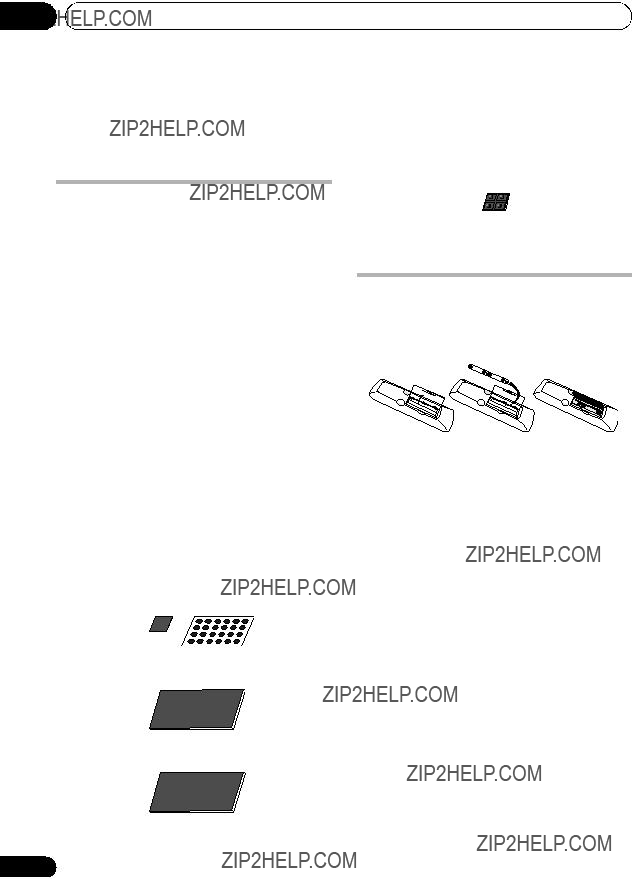
01 Before you start
Chapter 1
Before you start
Checking what???s in the box
Please check that you???ve received the following supplied accessories:
???Remote control
???AA/R6 dry cell batteries (to confirm system operation) x2
???Video cord
???AM loop antenna
???FM antenna
???Power cord:
Duty free model x2
Argentine (CX303 only), Taiwan, Philippines models x2
All other models x1
???Power plug adapter x1 (CX303 Argentine model only)
???Speaker cables x5
???Brackets x2
???Screw x8
???
???
???
???Spiral wrap x2
???These operating instructions
Loading the batteries
Use AA/R6 batteries with the supplied remote control. Make sure to follow the indications (???, ???) inside the compartment.
 Important
Important
Incorrect use of batteries may result in such hazards as leakage and bursting. Observe the following precautions:
???Never use new and old batteries together.
???Insert the plus and minus sides of the batteries properly according to the marks in the battery case.
???Batteries with the same shape may have different voltages. Do not use different batteries together.
???When disposing of used batteries, please comply with governmental regulations or environmental public instruction???s rules that apply in your country or area.
???
???Do not use or store batteries in direct sunlight or other excessively hot place, such as inside a car or near a heater. This can cause batteries to leak, overheat, explode or catch fire. It can also reduce the life or performance of batteries.
6
En

Before you start
Range of the remote control unit
The remote control has a range of about 7 meters. It may not work properly if:
???There are obstacles between the remote control and this unit???s remote sensor.
???Direct sunlight or fluorescent light is shining onto the remote sensor.
???This system is located near a device that is emitting infrared rays.
???This unit is operated simultaneously with another infrared remote control unit.
Attaching the
Use the
The illustration shows the CX505.
Center speaker
???CX500 model only ??? Attach the
01
???CX303 model only ??? Attach the
Placing the subwoofer
The subwoofer supplied with this system can be placed upright or on its side (flat). Choose the position that works best for your room, then attach the
Subwoofer
 Caution
Caution
???Do not place other speakers (front/center/ surround) on top of the subwoofer.
There is a risk that they will fall and cause injuries.
Removing the speaker grilles
CX505/CX303 model only
If necessary, remove the front speaker grilles as described below.
1Gently ease the grille loose by gripping the bottom and pulling towards you.
2Pull the top free in the same way.
When reattaching, start from the top then push the bottom in until secure.
???It is not recommended (due to dirt and dust) to leave the speaker grilles removed.
???Do not install your speakers overhead on the ceiling or wall. If improperly attached, the speaker grille can fall and cause damage or personal injury.
7
En

01 Before you start
Attaching the brackets
CX500 model only
Attach the brackets as described below. Before attaching, make sure to check which Home
theater sound setup you want to use.1
??? Stack the speakers and fix with the brackets.
Each speaker is provided with a
Standard surround/Front surround setup (Front surround mode):
Front surround setup (Extra Power mode):
Standard surround/Front surround setup (Front surround mode):
Bracket
Center speaker
Front surround setup (Extra Power mode):
Bracket
Surround speaker
Center speaker
Screw
Front speaker
As shown in the illustration, stack the speakers. Align the bracket with the respective upper screw hole on the back of the front speaker and fasten the screws securely.
 Caution
Caution
???Do not attempt to carry the speakers when they are connected with the bracket. Doing so may cause damage to the bracket or worsen damage to the bracket and speakers in the event they are dropped.
 Note
Note
1??? Refer to Home theater sound setup on page 24 for details on how to place your speakers.
???Standard surround/Front surround setup (Front surround mode) only - Attaching brackets is necessary only when mounting center speakers to right and left.
8
En

Before you start
CX505 ??? Center speaker, Surround speakers only
CX500 ??? Front speakers, Center speakers, Surround speakers
Depending on the speaker setup you choose, you can
The illustration shows the CX505.
5 mm
10 mm
5 mm to 7 mm
Before mounting (see above), keep in mind the following points:
???Remember that the speaker system is heavy and that its weight could cause the screws to work loose, or the wall material to fail to support it, resulting in the speaker falling. Make sure that the wall you intend to mount the speakers on is strong enough to support them. Do not mount on plywood or soft surface walls.
???Mounting screws are not supplied. Use screws suitable for the wall material and support the weight of the speaker.
01
 Caution
Caution
???If you are unsure of the qualities and strength of the walls, consult a professional for advice.
???Pioneer is not responsible for any accidents or damage that result from improper installation.
???Subwoofer and (CX303/CX505 model only) front speakers only ??? Do not attach these speakers to the wall or ceiling. They may fall off and cause injury.
9
En
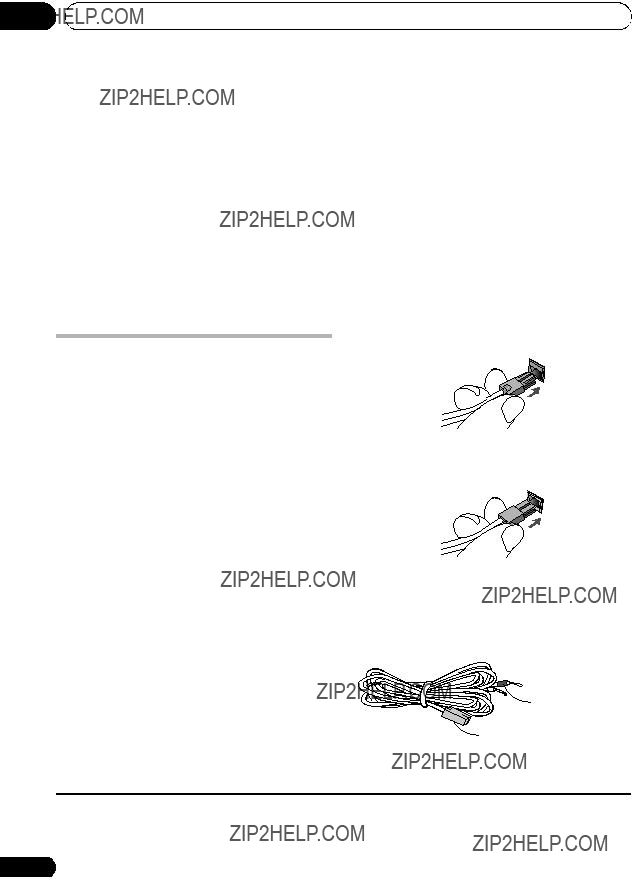
02 Connecting up
Chapter 2
Connecting up
 Important
Important
???Before making or changing any connections, switch off the power and unplug the power cord from the AC outlet.
???When making cable connections, make sure not to bend the cables over the top of this unit. This may cause a humming noise from the speakers.
Connecting the speaker terminals
Connect the wires from the speakers to the terminals on the main unit rear panel as shown below. Before connecting, you may want to consider the placement options available in
your room, and when using this system:1
???CX303 model only ??? Place the front left and right speakers at equal distances from the TV, then connect them as shown below.
???CX505/CX500 model only ??? A
 Caution
Caution
???Do not connect this speaker to any amplifier other than the one supplied with this system. Connection to any other amplifier may result in a malfunction or fire.
???Make sure that the bare speaker wires cannot touch each other, or come into contact with other metal parts once the unit is switched on.
??? Match the
Make sure to insert completely. The small lug at the
Upper terminals
Lower terminals
??? CX500 only: The front and surround speaker cables have a
 Note
Note
1 The speakers supplied with this system are magnetically shielded. However, placing them extremely close to a television may result in color distortion on the screen. If this happens, move the speakers a little further away and switch off the television for 15 to 30 minutes.
10
En

???Since there is only one terminal to connect the two center speakers, you will need to use the supplied
???Twist and pull off the protective shields on each wire.
???Connect the wires to the speaker. Each speaker in the illustration can be identified by means of the
???When connecting the center speakers, connect the
???When connections are completed, adjust the cable placements. If the speakers have been fixed with the brackets, fix the cable to the groove in the brackets as shown.
???Fasten the cables together with the spiral wrap.
Hold multiple cables together and place the wrap over the cables from the end. Wrap the spiral wrap with the cables in the center.
The spiral wrap may be cut at a desired length.
 To Main unit
To Main unit
11
En

02 Connecting up
Multichannel speaker connections
CX505/CX500 model only
Connect each speaker using the
The illustration shows the CX505.
Gray
Purple
White
Subwoofer
Center
Red
Green
Hints on speaker placement
The following guidelines will help you to get the best performance from your speaker system. See Home theater sound setup on page 24 for surround placement options with this system.
???Place the front left and right speakers at equal distances from the TV.
???Place the center speaker above or below the TV so that the sound of the center channel is localized at the TV screen.
???If possible, place the surround speakers slightly above ear level.
 Caution
Caution
???These speaker terminals carry
HAZARDOUS LIVE VOLTAGE. To prevent the risk of electric shock when connecting or disconnecting the speaker cables, disconnect the power cord before touching any uninsulated parts.
???If you choose to install the center speaker on top of the TV, be sure to secure it with putty, or by other suitable means, to reduce the risk of damage or injury resulting from the speaker falling from the TV in the event of external shocks such as earthquakes.
12
En
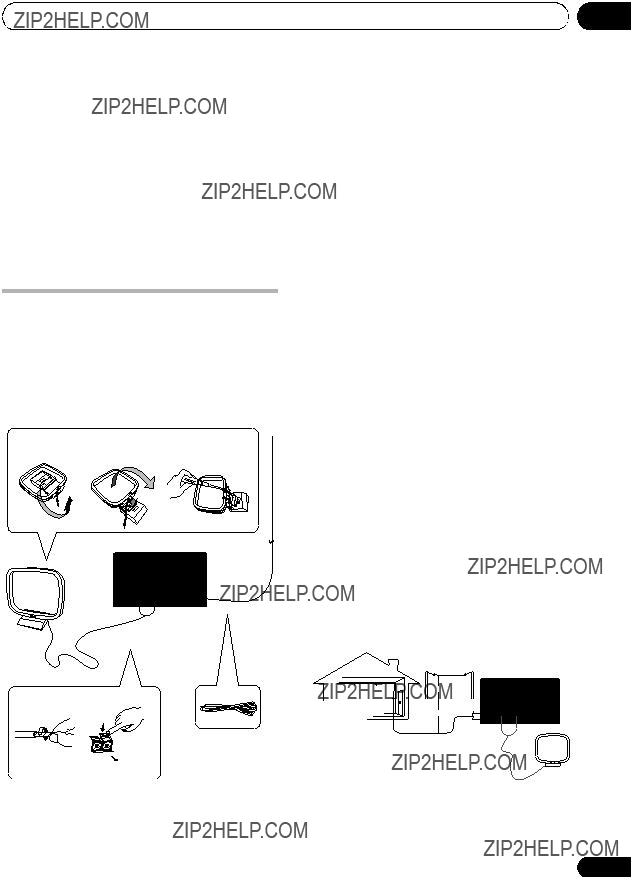
???Try not to place the surround speakers further away from the listening position than the front and center speakers. Doing so can weaken the surround sound effect.
???Make sure all speakers are installed securely to prevent accidents and improve sound quality.
???Subwoofer and (CX505 model only) front speakers only ??? Do not attach these speakers to the wall or ceiling. They may fall off and cause injury.
Connecting the radio antennas
Connecting the supplied antennas will allow you to listen to both AM and FM radio broadcasts. If you find that reception quality is poor, an outdoor antenna should give you better sound quality ??? see Connecting external antennas below for more on how to do this.
1Pull off the protective shields of both AM antenna wires.
2Push open the tabs, then insert one wire fully into each terminal, then release the tabs to secure the AM antenna wires.
3Fix the AM loop antenna to the stand.
To fix the stand to the antenna, bend in the direction indicated by the arrow (fig. a) then clip the loop onto the stand (fig. b).
???If you plan to mount the AM antenna to a wall or other surface, secure the stand with screws (fig. c) before clipping the loop to the stand. Make sure the reception is clear.
4Place the AM antenna on a flat surface and point in the direction giving the best reception.
Don???t let it come into contact with metal objects and avoid placing near computers, television sets or other electrical appliances.
5Connect the FM wire antenna in the same way as the AM loop antenna.
For best results, extend the FM antenna fully and fix to a wall or door frame. Don???t drape loosely or leave coiled up.
Connecting external antennas
ANTENNA
1 3
 2
2
ANTENNA
13
En
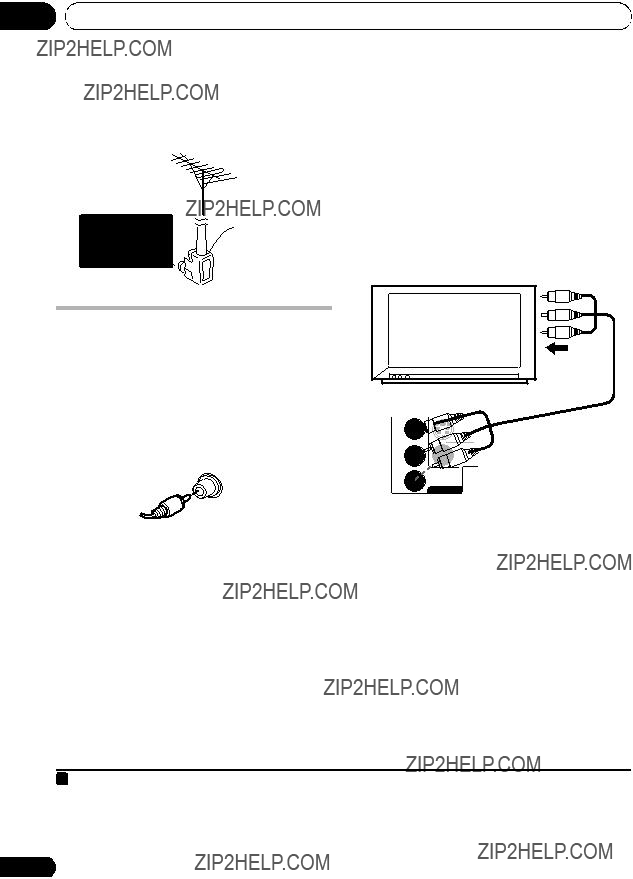
02 Connecting up
External FM antenna
Use a PAL connector to hook up an external FM antenna.
Connecting using the component video output
If your TV has component video inputs, you can use these instead of the standard video output
to connect this system to your TV.1 This should give you the best quality picture from the three types of video output available.
??? Use a component video cable to connect the COMPONENT VIDEO OUT to a set of component inputs on your TV.
Connecting to your TV
This system offers three types of video connections. If your TV has component video inputs, see Connecting using the component video output below.
1Use the supplied yellow video cable to connect the VIDEO OUT jack to a video input on your TV.
2Optionally: Use a stereo audio cable to connect the audio outs of your TV (or VCR) to the LINE IN jacks on the rear of this unit.
This will enable you to hear the TV (or VCR) sound through this system. See Connecting auxiliary components below for more on this.
To Component
input
COMPONENT
PRVIDEO
VIDEO OUT
About progressive scan video
Compared to interlace video, progressive scan video effectively doubles the scanning rate of the picture, resulting in a very stable, flicker- free image. Progressive scan video is available only from the component video output.
Compatibility of this player with
This player is compatible with progressive video Macro Vision System Copy Guard.2
Note
1 The component video output is switchable between interlaced and progressive formats. See Video Output settings on page 42. 2 Consumers should note that not all
14
En

Connecting auxiliary components
This system has a front panel audio input as well as stereo analog inputs on the rear panel.
???See Using the USB interface on page 35 to connect the front panel USB INPUT.
???Connect the LINE IN jacks on the rear panel to an auxiliary playback component.
These include components such as a VCR, cassette deck, or your TV. Connect using RCA
??? Connect the front panel AUDIO IN mini- plug jack to an auxiliary playback component.
These include components like a digital audio player or the analog audio output of a PC. Connect using a 1/4" stereo
Connecting the power
After making sure that everything is connected properly, connect the Media unit and the Power unit with attached cord, then plug in the power cord to the AC inlet, and the other end to a mains power outlet.
Power unit
Handle the power cord by the plug. Do not pull out the plug by tugging the cord and never touch the power cord when your hands are wet as this could cause a short circuit or electric shock. Do not place the unit, a piece of furniture, etc., on the power cord, or pinch the cord. Never make a knot in the cord or tie it with other cords. The power cords should be routed such that they are not likely to be stepped on. A damaged power cord can cause a fire or give you an electrical shock. Check the power cord once in a while. When you find it damaged, ask your nearest PIONEER authorized service center or your dealer for a replacement.
AC IN
 To AC outlet
To AC outlet
Media unit
BAL 75 ??
SYSTEM
R L
UB WOOFER
PEAKERS (4 - 6 )
Congratulations! You???re done setting up.
15
En

03 Controls and displays
Chapter 3
Controls and displays
8 9 10 11 12
1 ??? STANDBY/ON
Switches the player on or into standby.
2 Playback controls
The skip buttons are used for skipping on discs. The playback control buttons are used for playing, pausing and stopping playback.
3 Display
See Display on page 17.
4 VOLUME
Adjusts the volume level.
5 X.BOOM button
Switches on the bass boost (page 39).
6 ??? OPEN/CLOSE
Opens/closes the disc tray.
16
En

Controls and displays
Display
1Character display
2Format indicators
2PL II (CX505/CX500 only) ??? Lights during Dolby Pro Logic II decoding.
2D ??? Lights during playback of a Dolby Digital source.
DTS ??? Lights during playback of a DTS source.
3
Lights when the sleep timer is active.
4Tuner indicators

 ??? Lights when a broadcast is being received.
??? Lights when a broadcast is being received.
 ??? Lights when FM mono reception is selected.
??? Lights when FM mono reception is selected.
 ??? Lights when a stereo FM broadcast is being received in auto stereo mode.
??? Lights when a stereo FM broadcast is being received in auto stereo mode.
5Karaoke indicators
KARAOKE (Vocal cancel) ??? Vocals in the backing track are partially eliminated using EQ.
ECHO ??? Lights when the Karaoke ECHO effect is selected.
KEY ??? Lights when the Karaoke pitch control is selected.
L ??? Left channel only. Use for tracks that have a vocal recorded in the right channel. R ??? Right channel only. Use for tracks that have a vocal recorded in the left channel. L R ??? Use to put a
03
6Playback mode indicators
PGM ??? Lights during program play. RDM ??? Lights during random playback.
7SOUND
Lights when the SFC modes, XBOOM, bass, treble, ST.WIDE, MP3 EXP. (MP3 Expander) or VOICE. E. (Voice Enhancer) are active.
Remote control
The illustration shows the CX505/CX500.
1 ??? STANDBY/ON
Switches the player on or into standby.
2 Input source function select
Selects the source you want to listen to.
17
En

03 Controls and displays
3Number buttons and SHIFT functions
The number buttons can be used for selecting tracks directly, the functions above the buttons are accessed by pressing SHIFT at the same time as the button.
PGM (SHIFT+1) ??? Use to program/play a program list (page 31).
RPT (SHIFT+2) ??? Selects a repeat play mode (page 30).
RDM (SHIFT+3) ??? Selects a random play mode (page 31).
CLEAR ??? Clears an entry.
ENTER ??? Selects menu options, etc.
4HOME MENU
Press to display (or exit) the
5ENTER, TUNE & cursor control buttons
Navigates
6SYSTEM SETUP
Use to make various system settings (page 46). Also used when saving station presets when using the tuner (page 23).
7Sound Field/listening mode buttons SFC ??? Selects sound modes or custom settings from the Sound Field Control (page 38).
SURROUND (CX505/CX500 only) ??? Selects a surround listening mode (page 26).
EXT PWR (CX505/CX500 only) ??? Switches on the Extra Power mode (page 27).
FRT.SURR (CX505/CX500 only) ??? Switches on the Front Surround mode (page 27). SOUND MODE ??? Accesses settings in the Sound menu, such as the tone controls (page 38).
8Playback controls
??? ??? Starts/resumes playback.
??? and ???/??? ??? Use for reverse slow motion playback, frame reverse and reverse scanning.
18
??? and ???/??? ??? Use for forward slow motion playback, frame advance and forward scanning.
??? ??? Jumps to the next chapter or track.
??? ??? Jumps to the beginning of the current chapter or track, then to previous chapters/tracks.
??? ??? Pauses playback; press again to restart.
??? ??? Stops playback.
9DVD controls
AUDIO ??? Selects the audio channel or language (page 34).
SUBTITLE ??? Selects a subtitle display (page 33).
ANGLE ??? Changes the camera angle during DVD
ZOOM ??? Changes the zoom level (page 34).
10SHIFT
Press to access the functions/commands written in green on the remote.
11 X.BOOM
Switches the bass boost on or off (page 39).
12 PLAY LIST buttons
Adds tracks to (during playback), or selects the playlist (while stopped) (page 32).
13KARAOKE controls
KARAOKE ??? Selects audio channels for karaoke (page 37).
ECHO ??? Changes the echo level on the karaoke mics (page 37).
??? / ??? ??? Raises/lowers the pitch of the backing track (page 37).
14MENU
Displays the DVD menu (for Video CD/ Super VCDs, DivX video and WMA/MP3/
TOP MENU (SHIFT+MENU) Displays the top menu of a DVD disc.
En

15RETURN
Press to return to a previous menu screen.
TEST TONE (SHIFT+RETURN)
(CX505/CX500 only) ??? Press to output the test tone for speaker setup (page 25).
16SLEEP
Press to set the sleep timer (page 47).
DISPLAY
Switches between information displays (page 34).
MUTE
Mutes the volume (page 39).
17VOLUME
Adjusts the volume level.
19
En

04 Getting started
Chapter 4
Getting started
Using the
For ease of use, this system makes extensive use of graphical
All the screens are navigated in basically the same way, using the cursor buttons (???, ???, ???, ???) to change the highlighted item and pressing ENTER to select it.1
 Important
Important
???Throughout this manual, ???Select??? means use ???/???/???/??? to highlight an item on- screen, then press ENTER.
Button What it does
HOME Displays/exits the
MENU
???????????? Changes the highlighted menu item
ENTER Selects the highlighted menu item
RETURN Returns to the main menu without saving changes
 Tip
Tip
???You can change the
???The button guide at the bottom of every OSD screen shows you which buttons you???ll need to use for that screen.
Playing discs
1If the player isn???t already on, switch it on.
If you???re playing a disc with video, also turn on your TV and make sure that it is set to the correct video input.
2Press ??? OPEN/CLOSE on the front panel to load a disc.
Load a disc with the label side facing up, using the disc tray guide to align the disc (if you???re loading a
3 Press ??? (play) to start playback.
If you???re playing a DVD or Video CD/Super VCD, a menu may appear. See
If you loaded a disc containing JPEGs, a slideshow will start. See Playing a JPEG slideshow on page 28 for more on this.
???If a disc contains a mixture of DivX video and other media file types (MP3, for example), first select whether to play the DivX video files (DivX) or the other media file types
4 Adjust the volume.
Use the VOLUME control.
The basic playback controls for DVD, CD, Video CD/Super VCD, DivX video and WMA/MP3/
 Note
Note
1 The screen saver will appear after five minutes of inactivity.
20
En
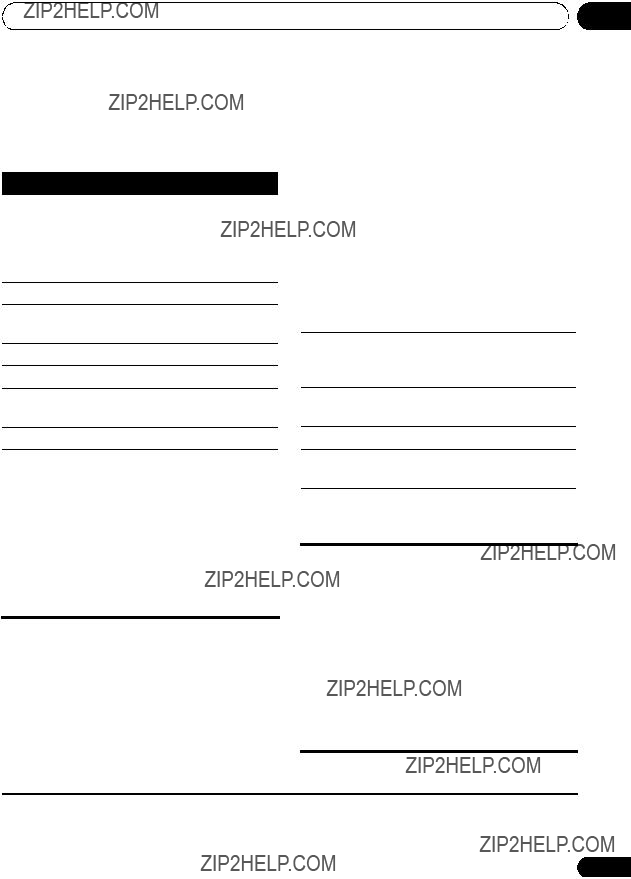
Basic playback controls
The following table shows the basic controls on
the remote for playing discs1. You can find other playback features in the chapter 7.
Button What it does
If you want to clear the resume point, press ??? (stop) while RESUME is displayed.
Many
???Starts/resumes normal playback. Sometimes
??? If the display shows RESUME or LAST MEM playback starts from the resume or last memory point (see
Resume and Last Memory below).
???Pauses/unpauses a disc.
???Stops playback or cancels the resume function (if the display shows RESUME).
???Press to start fast reverse scanning.
???Press to start fast forward scanning.
???Skips to the start of the current track or chapter, then previous tracks/chapters.
???Skips to the next track or chapter.
Numbers Use to enter a title/chapter/track number. Press ENTER to select.
???If the disc is stopped, playback starts from the selected title (for DVD) or track (for CD/Video CD/Super VCD).
???If the disc is playing, playback jumps to the start of the selected title (VR mode
automatically when you start playback; others only appear when you press MENU or TOP
MENU (SHIFT+MENU).
TOP MENU Displays the ???top menu??? of a DVD (SHIFT+MENU) disc ??? this varies with the disc.
MENU Displays a DVD disc menu ??? this varies with the disc and may be the same as the ???top menu???.
???????????? Moves the cursor around the screen.
ENTER Selects the current menu option.
RETURN Returns to the previously displayed menu screen.
Numbers Highlights a numbered menu option (some discs only). Press ENTER to select.
Video CD/Super VCD PBC menus
Some Video CD/Super VCDs have menus from which you can choose what you want to watch. These are PBC (Playback control) menus.
Resume and Last Memory
When you stop playback of a disc, RESUME shows in the display indicating that you can resume playback from that point.
With DVDs and Video CD/Super VCDs, even if
ejected, the play position is stored in memory.2 The next time you load the disc, the display shows LAST MEM and you can resume playback.
You can play a PBC Video CD/Super VCD without having to navigate the PBC menu by starting playback using a number button to select a track, rather than the ??? (play) button.
RETURN Displays the PBC menu.
 Note
Note
1 You may find with some DVD discs that some playback controls don???t work in certain parts of the disc.
2??? The Last Memory function may not work with some discs.
??? For
21
En

04 Getting started
Numbers Selects numbered menu options. Press ENTER to select.
???Displays the previous menu page (if there is one).
???Displays the next menu page (if there is one).
Listening to the radio
The tuner can receive both FM and AM broadcasts, and lets you memorize your favorite stations so you don???t have to manually tune in every time you want to listen (see
Memorizing stations on page 23 for more on this).
1 Press TUNER (FM/AM) to switch to the tuner, then press repeatedly to select the AM or FM band.
The display shows the band and frequency.
2 Tune to a frequency.
There are three tuning modes ??? manual, auto, and
???Manual tuning: Press TUNE +/??? repeatedly to change the displayed frequency.
???Auto tuning: Press and hold TUNE +/??? until the frequency display starts to move, then release. The tuner will stop on the next station it finds. Repeat to keep searching.
???
TUNE +/??? until the frequency display starts to move rapidly. Keep the button held down until you reach the frequency you want. If necessary, fine tune the frequency using the manual tuning method.
Improving FM stereo sound
If you???re listening to an FM station in stereo but the reception is weak, you can improve the sound quality by switching to mono.
1Tune to an FM radio station then press
SYSTEM SETUP.
2Use ???/??? to choose FM MODE then press
ENTER.
3Use ???/??? to select FM MONO then press
ENTER
The MONO indicator lights when the tuner is in mono reception mode.
Select FM AUTO above to switch back to auto- stereo mode (the  indicator lights when receiving a stereo broadcast).
indicator lights when receiving a stereo broadcast).
Reducing AM reception noise
If AM reception seems particularly poor, or the AM radio station you???re listening to seems noisy, try using the Noise Cut feature for better sound quality.
1Tune to an AM radio station then press
SYSTEM SETUP.
2Use ???/???to choose NOISECUT then press
ENTER.
3Use ???/???to select the noise cut mode then press ENTER.
Select an effect level between 1 and 3.
22
En
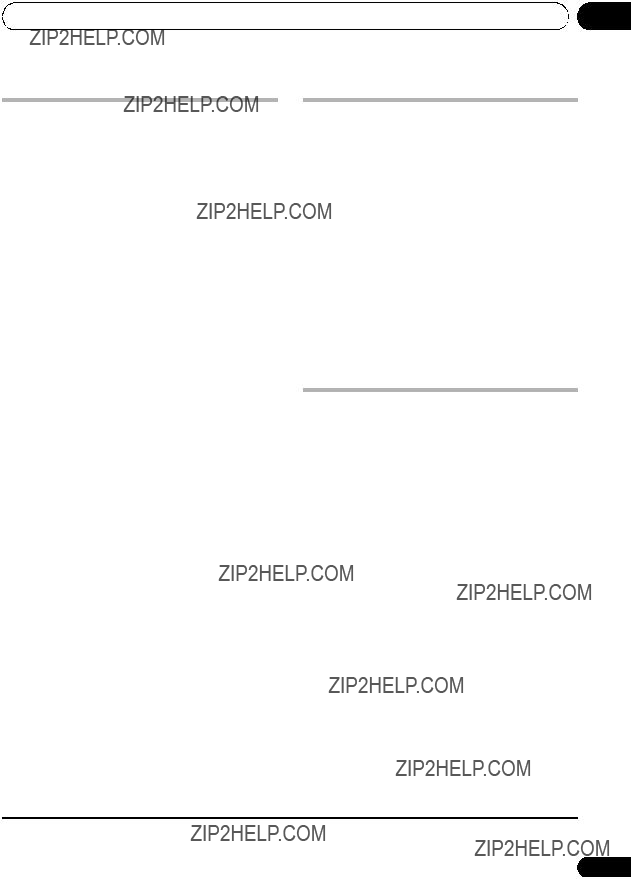
Getting started
Memorizing stations
You can save up to 30 station presets so that you always have easy access to your favorite stations without having to tune in manually each time.
Manually saving station presets
1Tune to an AM or FM radio station.
Select mono or
2Press SYSTEM SETUP and use ???/??? to choose ???ST.MEM.??? then press ENTER.
3Use ???/??? to select the station preset you want then press ENTER.
04
Listening to other sources
You can connect an external source for playback through this system???s speakers. See
Connecting auxiliary components on page 15 for more on this.
???To connect a USB device to the USB terminal, see USB playback on page 35.
1Make sure that the external source (TV,
MD player, etc.) is switched on.
2Press LINE to select the source connected to the rear panel LINE input and F. AUDIO to select the source connected to the front panel
3If necessary, start playback of the source.
Automatically saving station presets
1 Press SYSTEM SETUP, use ???/??? to choose ???A. PRESET??? then press ENTER.
Auto tuning starts in the FM band, stopping when a strong signal is received.
2 When auto tuning stops at a station, press ENTER to save the station as a preset, or press ???/??? to continue without saving.
Auto tuning resumes. After the FM band is finished, auto tuning continues in the AM band. Press ??? (stop) anytime to exit.
Auto tuning stops automatically after the AM band is finished, or after the limit of 30 presets has been reached. When this happens, the tuner automatically switches to preset
Dimming the display
You can choose one of two brightness settings for the front panel display.
1Press SYSTEM SETUP and use ???/??? to choose DIMMER then press ENTER.
2Use ???/??? to adjust then press ENTER to confirm and exit.
???DIMMER 1: Front panel display dims.
???DIMMER 2: Front panel display dims and automatically turns the display off after the unit has been left for two minutes.1
???OFF: Front panel display returns to the original brightness.
Listening to station presets
1Make sure the TUNER function is selected.
2Use ???/??? to select a station preset.
???You can also use the number buttons and ENTER to do this.
 Note
Note
1 When any key is pressed, the display turns on.
23
En
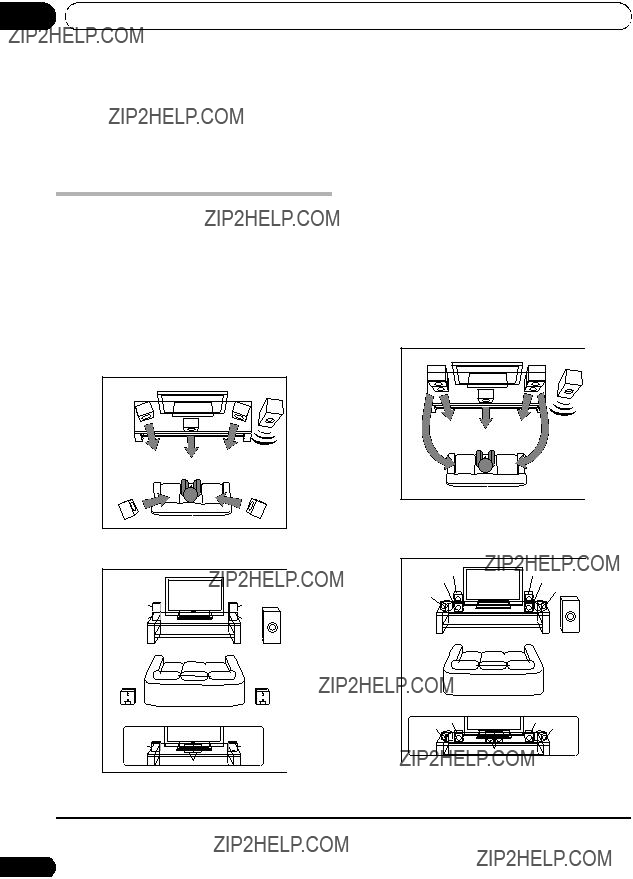
05 Setting up for surround sound
Chapter 5
Setting up for surround sound
CX505/CX500 model only
Home theater sound setup
Depending on the size and characteristics of your room, you can place your speakers in one
of two ways using this system:1
???Standard surround setup ??? This is a standard multichannel surround sound speaker setup for optimal 5.1 channel home theater sound.
CX505 model speaker configuration:
CX500 model speaker configuration:
Listening position
*When center speakers are placed in the center.
???Front surround setup ??? This setup is ideal when rear surround speaker placement isn???t possible or you want to avoid running long speaker cables in your listening area. Use this setup together with the Front Surround modes to take advantage of wall and ceiling reflections for a very realistic surround effect.
CX505 model speaker configuration:
CX500 model speaker configuration:
For Front surround mode
*When center speakers are placed in the center.
 Note
Note
1 See About the listening modes on page 26 for more on using the different listening modes with each speaker setup.
24
En

For Extra Power mode
Listening position
4Use the ???/??? buttons to adjust the speaker levels in turn.
You should hear the test tone at the same volume from each speaker when seated in the main listening position. The channel level range is ??10 dB.
5When you???re done, press TEST TONE
(SHIFT+RETURN) to exit test tone setup.
After placing your speakers, complete Setting the channel levels then refer to Speaker Distance on page 45 to complete your surround sound setup.
Setting the channel levels
Set the relative channel levels from your main listening position.1
1Switch to the DVD/CD or USB input source.
2Press TEST TONE (SHIFT+RETURN).
The test tone is output in the following order (from the speakers active in the current listening mode):
???L ??? Front left speaker
???C ??? Center speaker
???R ??? Front right speaker
???SR ??? Surround right speaker
???SL ??? Surround left speaker
???SW ??? Subwoofer2
3 Use the VOLUME +/??? button to adjust the volume to an appropriate level.
You can also use the front panel volume button.
 Note
Note
1??? Make sure headphones are unplugged.
???The channel balance can be adjusted (independently for each listening mode) while listening to any sound source you want: Press SYSTEM SETUP and use ???/??? to choose CH LEVEL then press ENTER, then use ???/??? to select channels and ???/??? to
adjust the level. Press ENTER when you???re finished.
2 Since the subwoofer produces
25
En

06 Home theater sound
Chapter 6
Home theater sound
CX505/CX500 model only
About the listening modes
As explained in Home theater sound setup on page 24, there are two basic surround speaker setup options available. Of course you can select any of the listening modes regardless of how you place your speakers, but you will achieve the best surround effect by using the listening modes in conjunction with your speaker setup:
???Standard surround setup ??? Use the Standard (Listening in surround sound below) surround listening modes with this setup.
???Front surround setup ??? See Using Front Surround on page 27 for the options available with this speaker setup.
Make sure you have completed Setting the channel levels on page 25.
Auto listening mode
The Auto listening mode is the simplest way to listen to any source as it was mastered: the output from the speakers mirrors the channels in the source material.
??? Press SURROUND to select the AUTO listening mode.1
Listening in surround sound
You can listen to stereo or multichannel sources in surround sound. Surround sound is generated from stereo sources using one of the Dolby Pro Logic decoding modes.
1Switch to the DVD/CD or USB input source.
2Press SURROUND repeatedly to select a
listening mode.
The choices that appear in the display will vary according to the type of source that???s playing.
???AUTO ??? Auto listening mode (see above)
???DOLBY PL (Dolby Pro Logic) ??? 4.1 channel surround sound for use with any two- channel source
???MOVIE (Dolby Pro Logic II Movie) ??? Pro Logic II 5.1 channel surround sound, especially suited to movie sources (use with any
???MUSIC (Dolby Pro Logic II Music) ??? Pro Logic II 5.1 channel surround sound, especially suited to music sources, for use with any
???STEREO ??? See Listening in stereo below
 Note
Note
1 If the source is Dolby Digital or DTS, the corresponding indicator lights in the front panel display.
26
En

Home theater sound
Using Front Surround
The Front Surround mode and Extra Power mode are effective when DVD/CD or USB is selected as the input source and you are using the Front surround speaker setup as described in Home theater sound setup on page 24.
Using the Front Surround mode
???CX505 model ??? The surround speakers should be placed on top of the front speakers and oriented (about 60??) towards the walls.
???CX500 model ??? The surround speakers should be placed beside the front speakers and oriented (about 60??) towards the walls.
??? Press EXT PWR/FRT.SURR to select the
Front Surround mode.
???FRT.SURR ??? Use to provide rich surround sound effect.
???OFF ??? Switches the Front Surround mode off.
06
Using the Extra Power mode
The Extra Power mode uses the Front surround setup as described in Home theater sound setup on page 24, but the surround speakers and (CX500 only) center speakers should be pointed in the same direction as the front speakers (towards the listening position).
??? Press EXT PWR/FRT.SURR to select the
Extra Power mode.
???EXT POWER ??? Outputs stereo sound (in the case of
???OFF ??? Switches the Extra Power mode off.
Listening in stereo
You can listen to any source ??? stereo or multichannel ??? in stereo. When playing a multichannel source, all channels are downmixed to the front left/right speakers and the subwoofer.
??? Press SURROUND repeatedly until
STEREO shows in the display.
Listening with headphones
When headphones are connected, only the STEREO mode is available.1
 Note
Note
1 When you disconnect them it reverts to the previous mode.
27
En

07 Disc playback features
Chapter 7
Disc playback features
 Important
Important
???Many of the functions covered in this chapter apply to DVD discs, Video CDs/ Super VCDs, CDs, DivX video and WMA/
1During playback, press ??? (pause).
2Press and hold ???/???or ???/???until slow motion playback starts.
Press repeatedly to change the slow motion speed (shown
???To resume playback, press ??? (play).2
???Some DVDs restrict the use of some functions (random or repeat, for example) in some or all parts of the disc. This is not a malfunction.
???When playing Video CD/Super VCDs, some of the functions are not available during PBC playback. If you want to use them, start the disc playing using a number button to select a track.
Scanning discs
Frame advance/frame reverse
With DVD discs, you can move advance/back
1During playback, press ??? (pause).
2Press ???/??? or ???/??? to reverse or advance a frame at a time.
???To resume playback, press ??? (play).2
You can
??? During playback, press ???or ???to start scanning.
Press repeatedly to increase the scanning speed (shown
??? To resume playback, press ??? (play).2
Playing in slow motion
You can play DVDs, Video CD/Super VCDs and DivX video at four different forward slow motion speeds. DVD discs can also be played in reverse slow motion.
Playing a JPEG slideshow
After loading a disc containing JPEG pictures, press ??? to start a slideshow from the first
folder/picture on the disc.3 The player displays the pictures in each folder in alphabetical order.
???If the disc contains
Pictures are automatically adjusted so that they fill as much of the screen as possible.
 Note
Note
1 Only one speed is available for DivX video discs.
2??? Depending on the disc, normal playback may automatically resume when a new chapter is reached on a DVD disc.
???For Video CDs/Super VCDs in PBC mode and
3 ??? The time it takes for the player to load a file increases with large file sizes.
???Discs can contain up to 299 folders and up to 648 folders and files combined.
28
En
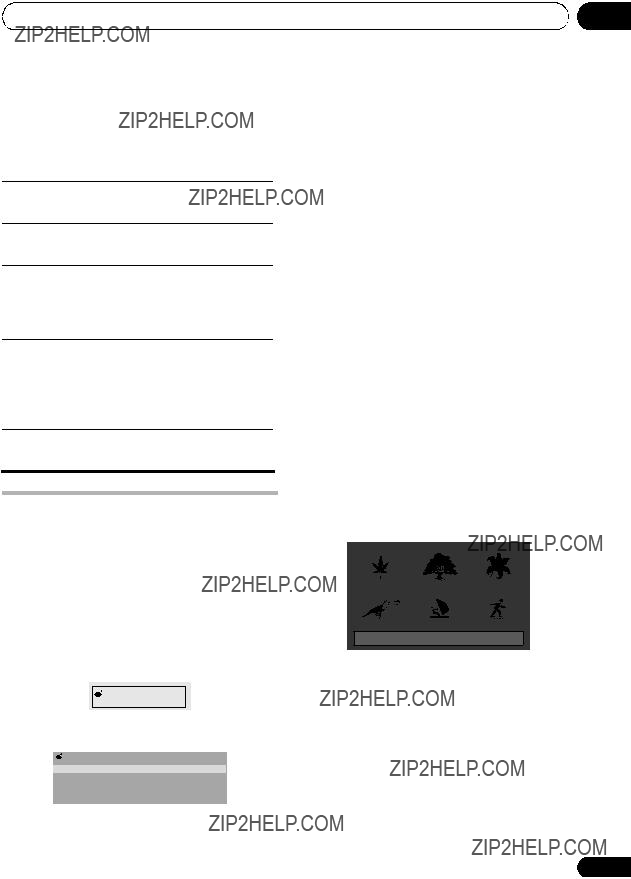
Disc playback features
While the slideshow is running:
07
The options available depend on the kind of disc loaded and whether the disc is playing or not, but include:
???Pauses the slideshow (or audio); ??? Title ??? Titles from a
press again to restart.
???Jumps to the previous picture (or audio file with audio playback).
???Jumps to the next picture (or audio file with audio playback).
???/???/???/??? Pauses the slideshow and rotates/flips the displayed picture (Press ??? (play) to restart slideshow).
ZOOM Pauses the slideshow and zooms the picture. Press again to toggle between 1x, 2x and 4x zoom (Press ??? (play) to restart slideshow).
MENU Displays the Disc Navigator
screen (see below).
???Chapter ??? Chapters from the current title of a
???Track ??? Tracks from a Video CD/Super VCD disc.
???Time ??? Thumbnails from a Video CD/Super VCD disc at 10 minute intervals.
???Original: Title ??? Original titles from a VR mode
???Playlist: Title ??? Playlist titles from a VR mode
???Original: Time ??? Thumbnails from the Original content at 10 minute intervals.
???Playlist: Time ??? Thumbnails from the Playlist at 10 minute intervals.
The screen shows up to six moving thumbnail images displayed one after another. To display the previous/next six thumbnails, press ???/
???.
Browsing DVD or Video CD/ Super VCD discs with the Disc Navigator
Use the Disc Navigator to browse through the contents of a DVD or Video CD/Super VCD disc to find the part you want to play.
1 During playback, press HOME MENU and select ???Disc Navigator??? from the on- screen menu.
 Disc Navigator
Disc Navigator
2 Select a view option.
 Disc Navigator
Disc Navigator
Title
Chapter
3 Select the thumbnail image for what you want to play.
Disc Navigator: Title
01- 49:
You can use either the ???/???/???/???and ENTER to select a thumbnail, or the number buttons.
To select using the number buttons, enter a
29
En

07 Disc playback features
Browsing WMA, MP3,
Use the Disc Navigator to find a particular file or folder by filename.
1 Press HOME MENU and select ???Disc
Navigator??? from the
Folder1
Folder2
Folder3
Folder4
2 Use ???/???/???/??? and ENTER to navigate.
Use ???/??? to move up/down the folder/file list. Use ??? to return to the parent folder.1
Use ENTER or ??? to open a highlighted folder.
???When a JPEG file is highlighted, a thumbnail image is displayed on the right.
Folder2
 File1
File1
File2
File3
File4
File5
 Tip
Tip
???You can also play a JPEG slideshow while listening to
???To play the contents of the whole disc rather than just the current folder, exit the Disc Navigator and start playback using the ??? (play) button.
Looping a section of a disc
The
1During playback, press HOME MENU and select ???Play Mode???.
2Select
3Press ENTER on ???A (Start Point)??? to set the loop start point.
4Press ENTER on ???B (End Point)??? to set the loop end point.
After pressing ENTER, playback jumps back to the start point and plays the loop.
3 To play the highlighted track or DivX video file or display the highlighted JPEG file, press ENTER.
5 To resume normal playback, select ???Off???.
???When a
???When a JPEG file is selected, a slideshow begins, starting with that file, and continues to the end of the folder.
Using repeat play
In addition to various repeat play options, it???s also possible to use repeat play together with program play (see Creating a program list on page 31).
1 During playback, press HOME MENU and select ???Play Mode???.
 Note
Note
1 You can also do this by going to the ???..??? folder at the top, then pressing ENTER.
30
En
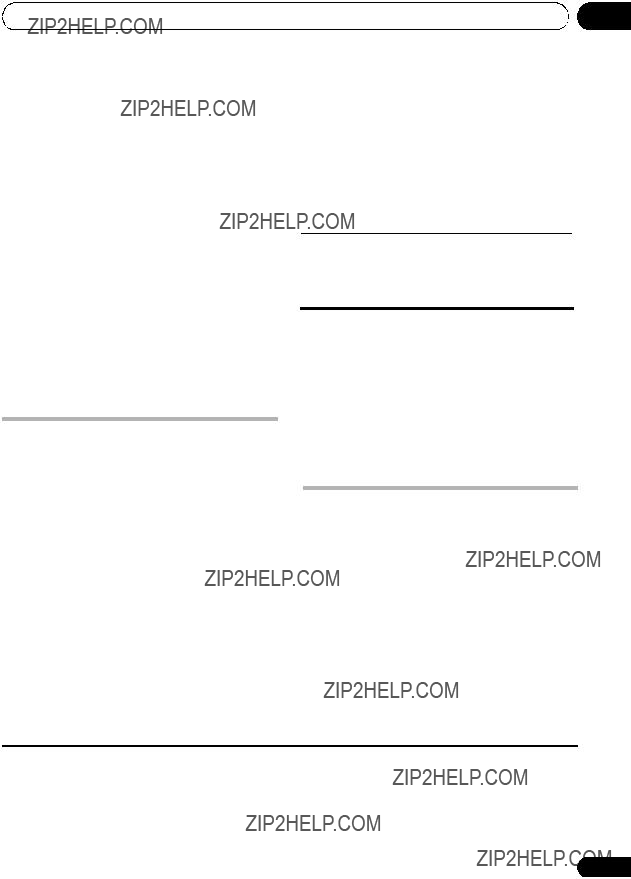
2 Select ???Repeat??? then select a repeat play
option.1
If program play is active, select Program Repeat to repeat the program list, or Repeat Off to cancel.
???For DVD discs, select Title Repeat or
Chapter Repeat.
???For CDs and Video CD/Super VCDs, select
Disc Repeat or Track Repeat.
???For DivX video discs, select Title Repeat
(or Repeat Off).
 Tip
Tip
???You can also use the RPT (SHIFT+2) button on the remote to select a repeat play option. The repeat modes available are the same as those from the Play Mode menu.
 Tip
Tip
???Use the following controls during random play:
???Selects a new track/title/chapter at random.
???Returns to the beginning of the current track/title/chapter; further presses select another random track/title/chapter.
???You can also use the RDM (SHIFT+3) button on the remote to select a random play mode. The random modes available are the same as when choosing from the Play Mode menu. Press ENTER to start random play.
Using random play
Use this function to play titles or chapters
VCD) in a random order.2
1During playback, press HOME MENU and select ???Play Mode???.
2Select ???Random??? then select an option.
???For DVD discs, select Random Title or
Random Chapter.
???For CDs and Video CD/Super VCDs, select On or Off to switch random play on or off.
???Random play remains in effect until you select Random Off from the random play menu options.
Creating a program list
This feature lets you program the play order of titles/chapters/tracks on a disc.3
Using the OSD
1During playback, press HOME MENU and select ???Play Mode???.
2Select ???Program??? then select ???Create/Edit??? from the list of program options.
3Use ???/???/???/??? and ENTER to select a title, chapter or track for the current step in the program list.
For a DVD disc, you can add a title or a chapter.
 Note
Note
1 You can???t use repeat play with
2 ??? You can set the random play option when a disc is playing or stopped. However, you can???t use random play together with program play.
??? You can???t use random play with VR format
3 You can???t use Program play with VR format
31
En

07 Disc playback features
???For a CD or Video CD/Super VCD, select a track to add to the program list.
After pressing ENTER to select the title/ chapter/track, the step number automatically moves down one.
4Repeat step 3 to build up a program list.
A program list can contain up to 24 steps.
???You can insert steps by just highlighting the position where you want the new step to appear and entering a title/chapter/track number.
???To delete a step, highlight it and press
CLEAR.
5To play the program list, press ??? (play).
Program play remains active until you turn off program play (see below), erase the program list (see below), eject the disc or switch off.
 Tip
Tip
???Use the following controls during program play:
HOME Save the program list and exit MENU without starting playback.
???Skip to the next step in the program list.
Using the front panel display
Even though the OSD is available for CDs, the front panel display provides information to make a program list easily. If a disc is playing, stop it first.
1 Press PGM (SHIFT+1).
You???re prompted to enter a track for the first step in the program list.
2 Use the number buttons to select a track, then press ENTER.
If you make a mistake, press CLEAR to delete the last (most recently) programmed track.
3Repeat step 2 to build up a program list.
A program list can contain up to 24 steps.
4To play the program list, press ??? (play).
???Program play remains active until you press ??? (stop), clear the playlist (see tip above), eject the disc or switch off the player.
Using Playlists
With this feature, you can make up to three playlists of 30 files each for discs containing WMA, MP3,
Since this unit will remember all playlists for the last ten discs you have loaded, this is useful for if you have a large number of files that you
want to organize quickly and easily.1
Other functions available from the
program menu
Programming playlists
There are a number of other options in the program menu in addition to Create/Edit.
???Playback Start ??? Starts playback of a saved program list
???Playback Stop ??? Turns off program play, but does not erase the program list
???Program Delete ??? Erases the program list and turns off program play
1With the disc stopped, press HOME
MENU and select ???Disc Navigator??? from the
2Select the file you want to add to the playlist.
See Browsing WMA, MP3,
 Note
Note
1 The disc must be loaded for the files in your playlist to play back.
32
En
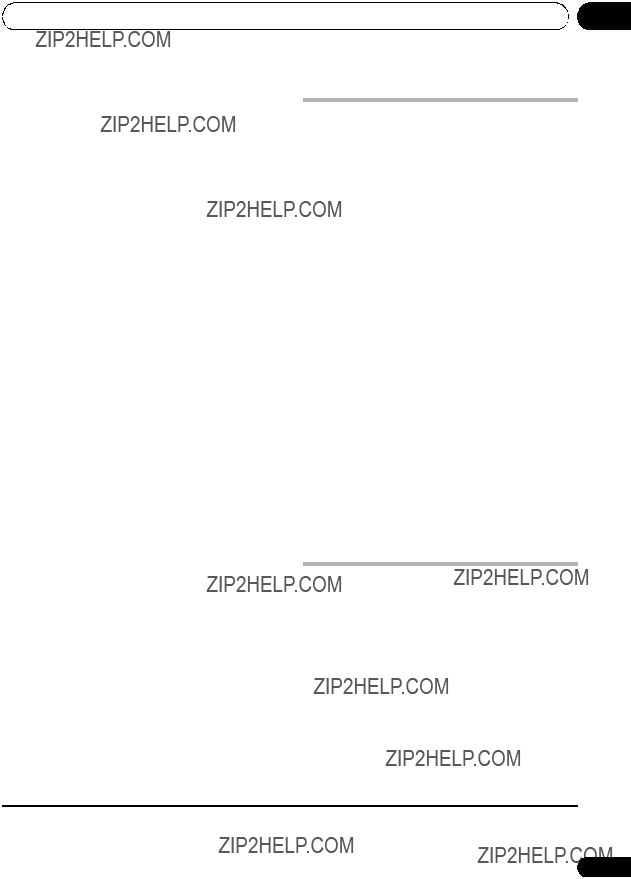
3 Press PLAY LIST 1, 2 or 3.
The file is added to the playlist you select.
4 Repeat steps 2 and 3 until you???re done.
 Tip
Tip
???To add files without the
Searching a disc
You can search DVD discs by title or chapter number, or by time; CDs and Video CD/Super VCDs by track number or time; DivX video discs by time.
1Press HOME MENU and select ???Play
Mode???.
2Select ???Search Mode???.
The search options that appear depend on the kind of disc loaded.
Listening to playlists
??? With playback stopped, press PLAY LIST 1, 2 or 3.
During playback, PGM lights in the front panel display.
???If no playlist has been programmed, NO LIST shows in the front panel display.
???If the playlist contains both JPEG and audio files, playback of the slideshow and audio files starts.
Clearing files from a playlist
3Select a search mode.
???The disc must be playing in order to use time search.
4Use the number buttons to enter a title, chapter or track number, or a time.
???For a time search, enter the number of minutes and seconds into the currently playing title (DVD/ DivX video) or track (CD/ Video CD/Super VCD) you want playback to resume from. For example, press 4, 5, 0, 0 to have playback start from 45 minutes into the disc. For 1 hour, 20 minutes and 30 seconds, press 8, 0, 3, 0.
1Start playback of your playlist.
2Press HOME MENU and select ???Disc
Navigator???.
3From the ???Disc Navigator??? screen, select the file you want to remove from the playlist and press CLEAR.
5 Press ENTER to start playback.
Switching subtitles
Some DVD discs and DivX video discs have subtitles in one or more languages; the disc box will usually tell you which subtitle languages are available. You can switch
subtitle language during playback.1
??? Press SUBTITLE repeatedly to select a subtitle option.
???To set subtitle preferences, see Language settings on page 42.
???See Displaying DivX subtitle files on page 49 for more on DivX subtitles.
 Note
Note
1 Some discs only allow you to change subtitle language from the disc menu. Press TOP MENU (SHIFT+MENU) or MENU to access.
33
En

07 Disc playback features
Switching language/audio channels
When playing discs recorded with dialog in two or more languages, or with
??? Press AUDIO repeatedly to select an audio language option.
???To set audio language preferences, see
Language settings on page 42.
Displaying disc information
Various track, chapter and title information can be displayed
??? To show/switch/hide the information displayed, press DISPLAY repeatedly.
Limited disc information also appears in the front panel display. Press DISPLAY to change the displayed information.
Zooming the screen
Using the zoom feature you can magnify a part of the screen by a factor of 2 or 4, while watching a DVD, DivX video title or Video CD/ Super VCD or playing a JPEG disc.
1During playback, use the ZOOM button to select the zoom factor (Normal, 2x or 4x).
2Use ???/???/???/??? to change the zoomed area.
You can change the zoom factor and the
zoomed area freely during playback.3
Switching camera angles
Some DVD discs feature scenes shot from two or more angles ??? check the disc box for details.
When a  icon appears on screen (this can be switched off if you prefer ??? see Display settings on page 43).
icon appears on screen (this can be switched off if you prefer ??? see Display settings on page 43).
??? During playback (or when paused), press
ANGLE to switch angle.
 Note
Note
1 Some Super VCDs have two soundtracks. With these discs you can switch between the two soundtracks as well as individual channels in each.
2 Some discs only allow you to change audio language from the disc menu. Press TOP MENU (SHIFT+MENU) or MENU to access.
3 ??? Since DVD, Video CD/Super VCD, DivX video title and JPEG pictures have a fixed resolution, picture quality will deteriorate, especially at 4x zoom. This is not a malfunction.
??? If the navigation square at the top of the screen disappears, press ZOOM again to display it.
34
En

USB playback
Chapter 8
USB playback
Using the USB interface
It is possible to listen to
storage device2 as shown below.
1With the player switched on, press USB.
Make sure your TV is on and set to the correct video input.
2Connect your USB device.
The USB terminal is located on the front panel.
08
 Important
Important
If a USB ERR message lights in the display, it may mean that the power requirements of the USB device are too high for this player, or that the device is incompatible. Try the following:
???Switch the player off, then on again.
???Reconnecting the USB device with the player switched off.
???Selecting to another input source (like DVD/CD), then back to USB.
???Using a dedicated AC adapter (supplied with the device) for USB power.
If this doesn???t remedy the problem, it is likely your USB device is incompatible.
USB
(Type A)
USB mass storage device
Basic playback controls
The following table shows the basic controls on the remote for USB playback.
Button What it does
???Starts normal playback.
???Pauses/unpauses playback.
???Stops playback.
3 Press ??? (play) to start playback.
If your USB device contains JPEGs, a slideshow will start. See Playing a JPEG slideshow on page 36 for more on this.
???Make sure USB DATA is showing in the front panel display (or the system is in standby) when disconnecting.
???Press to start fast reverse scanning.
???Press to start fast forward scanning.
???Skips to the start of the current file, then previous files.
???Skips to the next file.
 Note
Note
1 This includes playback of
2 ??? Compatible USB devices include external magnetic hard drives, portable flash memory (particularly keydrives) and digital audio players (MP3 players) of format FAT16/32. It is not possible to connect this unit to a personal computer for USB playback.
???Pioneer cannot guarantee compatibility (operation and/or bus power) with all USB mass storage devices and assumes no responsibility for any loss of data that may occur when connected to this unit.
???With large amounts of data, it may take longer for the system to read the contents of a USB device.
35
En
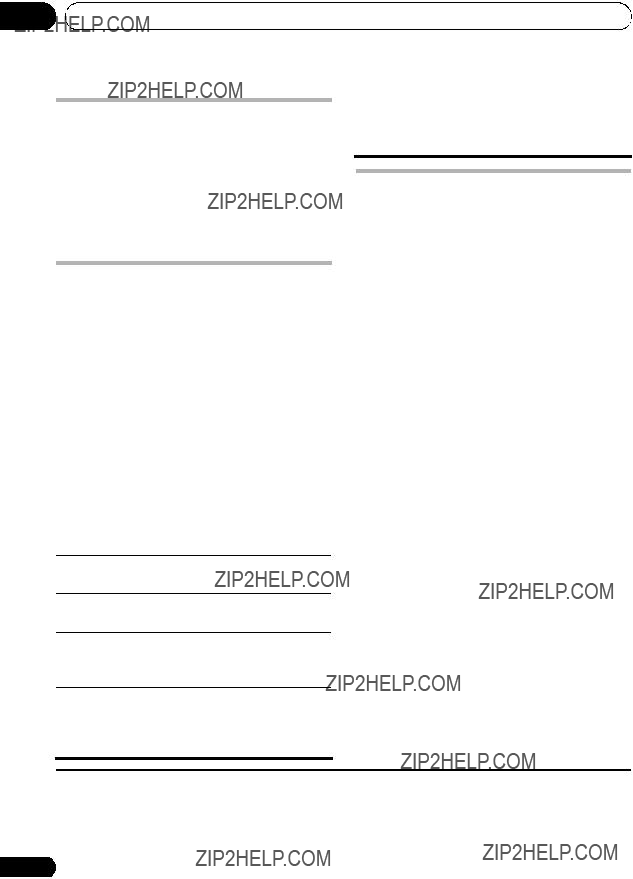
08 USB playback
Scanning files
You can
??? During playback, press ??? or ???.
Press repeatedly to increase the scanning speed (shown
??? To resume playback, press ??? (play).1
MENU Displays the Navigator screen (see below).
Browsing files with the Navigator
Use the Navigator to find WMA, MP3,
Playing a JPEG slideshow
Press ??? to start a slideshow from the first
folder/picture.2 The pictures in each folder are displayed in order.
???If the device contains
Pictures are automatically adjusted so that they fill as much of the screen as possible.
While the slideshow is running:
???Pauses the slideshow (or audio); press again to restart.
???Jumps to the previous picture (or audio file with audio playback).
???Jumps to the next picture (or audio file with audio playback).
???/???/???/??? Pauses the slideshow and rotates/flips the current picture (Press ??? to restart slideshow).
ZOOM Pauses the slideshow and zooms the picture. Press again to toggle between 1x, 2x and 4x zoom (Press ??? to restart slideshow).
1 Press MENU then use ???/???/???/??? and
ENTER to navigate.
Use ???/??? to move up/down the folder/file list. Use ??? to return to the parent folder.4
Use ENTER or ??? to open a highlighted folder.
???When a JPEG file is highlighted, a thumbnail image is displayed on the right.
2 To play the highlighted track or display the highlighted JPEG file, press ENTER.
???When a
???When a JPEG file is selected, a slideshow begins, starting with that file, and continues to the end of the folder.
 Tip
Tip
???You can also play a JPEG slideshow while listening to
???To play all of the contents, rather than just the current folder, exit the Navigator and start playback using the ??? (play) button.
 Note
Note
1 With
2??? The time it takes for the player to load a file increases with large file sizes.
???USB devices can contain up to 299 folders and up to 648 folders and files combined. 3 Filenames may be displayed incorrectly with some digital audio players.
4 You can also do this by going to the ???..??? folder at the top, then pressing ENTER.
36
En

Chapter 9
Singing karaoke
Singing karaoke
Using the karaoke features you can plug in a microphone and mix the sound of your own
voice with a backing track1. You can select a backing track from audio sources such as CDs, DVDs, VCDs or USB devices. Adjust the microphone level relative to the backing track.
MIN MAX
1Set the MIC VOL knob (front panel) to minimum.
2Plug in the microphone(s).
If you???re only using one mic, plug it into the
MIC (MAIN) jack. The MIC (SUB) jack can be used only if MIC (MAIN) is also connected.
???If the microphone has an on/off switch, make sure it???s on.
???L CH ??? Left channel only. Use for tracks that have a vocal recorded in the right channel.
???R CH ??? Right channel only. Use for tracks that have a vocal recorded in the left channel.
???L+R CH ??? Use to put a
???OFF ??? Switches the Karaoke mode off.
5Play the backing track.
6Adjust the MIC VOL knob.
To avoid unpleasant feedback, make sure you don???t point the microphone(s) at the speakers.3
7 Sing!
Changing the vocal mix
Adding some effects to the microphone mix
can sometimes improve the overall sound.4 You can choose between three echo levels.
??? To add effects to the microphone mix, press ECHO.
Pressing repeatedly switches between echo levels 1 to 3 and off.
3Load a karaoke backing disc.
4To change the mix (CD or Video CD/Super VCD only), press KARAOKE.
Changing the backing track
You may want to lower or raise the pitch of the backing track to match your vocal range.5
Press to switch between these options:2
???KARAOKE (Vocal cancel) ??? Backing track vocals are partially eliminated using EQ.
???Press KEY CONTROL
??? (SHIFT+KARAOKE) or ??? (SHIFT+ECHO) to raise or lower the pitch of the backing track.
 Note
Note
1 ??? These features are only possible when a microphone is connected. If you try to use KARAOKE, ECHO, ??? (SHIFT+KARAOKE), or ??? (SHIFT+ECHO) when no mic is connected, a ???NO MIC??? error message is displayed. Also note that during DVD playback, when you connect a mic sound settings are automatically switched to STEREO playback and downmixes multichannel sources to 2.1 channels.
??? These features are only available with the DVD/CD or USB input functions. 2 The current setting is first shown in the display.
3 Depending on the microphone level, the sound of the disc may distort. If this happens, turn down the volume. 4 You cannot adjust Sound menu, SFC modes or bass boost controls when a microphone is plugged in.
5 This feature is not compatible with DTS signals.
37
En

10 Adjusting the sound
Chapter 10
Adjusting the sound
Using the Sound menu
There are several optional sound settings you can make from the sound menu.
1Press SOUND MODE.
2Use ???/??? to choose the setting you want to adjust.
The current setting is shown for each option (in the order shown in step 3, with the defaults in bold) as you cycle through the display.
3 Use ???/??? to adjust.
Make adjustments to the following settings:
4Repeat steps 2 and 3 for other settings.
5When you???re done, press ENTER to leave the Sound menu.
 Tip
Tip
???You can store your current bass, treble as a preset. Simply hold ENTER for three seconds, then press ENTER again to confirm when USER shows in the display. You can now select this preset from the
SFC menu (see Using the Sound Field Control below).
Using the Sound Field Control
Depending on the source you???re listening to, you may want to use the Sound Field Control to match the source you???re listening to.
??? Press SFC repeatedly to select a mode.
The options are as follows:
???ROCK ??? Live concert sound for rock music.
???POP ??? Live concert sound for pop music.
???DANCE ??? Good for music with lots of bass.
???CLASSIC ??? Large concert hall type sound.
???DRAMA ??? Good for movies with lots of dialog.
???ACTION ??? Good for movies with dynamic sound tracks.
???USER ??? See Tip above.
???OFF
 Note
Note
1 When turned on, the SFC mode will turn off.
2??? When turned on, the SFC mode and Extra Power mode will turn off.
??? For multichannel DVD disc only.
38
En

Boosting the bass level
If you want to bring up the low end for certain kinds of music or sound sources, you can use the bass boost to do so.
??? Press X.BOOM repeatedly to select a mode.
The options are as follows (the X.BOOM LED lights as indicated in parantheses):
???AUTO ??? Automatically selects XBOOM MS or XBOOM MV (depending on the source). For DVD video/Video CD/ SuperVCD/DivX disc, XBOOM MV will be selected.
For other sources, XBOOM MS will be selected.
???XBOOM MS ??? Good for music with lots of bass (blue).
???XBOOM MV ??? Boosts low frequency (bass) sounds in movies (orange).
???OFF ??? Switches the bass boost off.
Muting the sound
??? Press MUTE to switch off the volume.
To switch the sound back on, adjust the volume or press MUTE again.
39
En
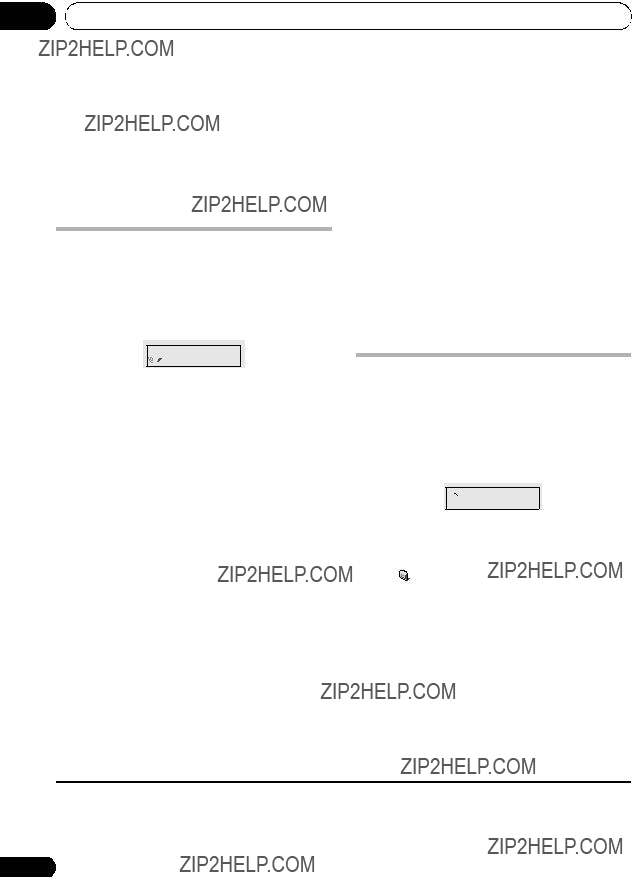
11 Audio Settings and Video Adjust menu
Chapter 11
Audio Settings and Video Adjust menu
Audio Settings menu
The Audio Settings menu offers features for adjusting the way discs sound.
1 Press HOME MENU and select ???Audio
Settings??? from the
 Audio Settings
Audio Settings
Virtual Surround
CX303 only
??? Settings: On, Off (default)
Switch on Virtual Surround to enjoy realistic surround sound effects from just three
speakers.2
Video Adjust menu
2 Select and change settings using ???/???/ ???/??? and ENTER.
From the Video Adjust screen you can adjust various settings that affect how the picture is presented.
Audio DRC
???Settings: High, Medium, Low,
Off (default)
When watching Dolby Digital DVDs at low volume, it???s easy to lose the quieter sounds completely ??? including some of the dialog. Switching Audio DRC (Dynamic Range Control) to on can help by bringing up the quieter sounds, while controlling loud peaks.
How much of a difference you hear depends on the material you???re listening to. If the material doesn???t have wide variations in volume, you
may not notice much change.1
1 Press HOME MENU and select ???Video
Adjust??? from the
 Video Adjust
Video Adjust
2 Make settings using ???/???/???/??? and
ENTER.
You can adjust the following settings:
???Sharpness ??? Adjusts the sharpness of edges in the picture (Fine, Standard, Soft)
???Brightness ??? Adjusts the overall brightness
 Note
Note
1??? Audio DRC is only effective with Dolby Digital audio sources.
??? The effect of Audio DRC also depends on your speakers and settings.
2??? 96 kHz Linear PCM audio is automatically downsampled to 48 kHz if Virtual Surround is switched on.
??? How good the surround effect is varies with the disc.
40
En

???Contrast ??? Adjusts the contrast between light and dark
???Gamma ??? Adjusts the ???warmth??? of the picture (High, Medium, Low, Off)
???Hue ??? Adjusts the red/green balance (Green 9 to Red 9)
???Chroma Level ??? Adjusts how saturated colors appear
Adjust the Brightness, Contrast, Hue and
Chroma Level settings using ???/???.
3 Press ENTER to return to the Video Adjust screen, or HOME MENU to exit.
41
En

12 Initial Settings menu
Chapter 12
Initial Settings menu
Using the Initial Settings menu
The Initial Settings menu provides audio and video output settings, parental lock settings, and display settings, among others.
If an option is grayed out it means that it cannot be changed at the current time. This is usually because a disc is playing. Stop the disc, then change the setting.
1Press DVD/CD.
2With playback stopped, press HOME MENU and select ???Initial Settings???.
 Initial Settings
Initial Settings
3 Use ???/???/???/??? and ENTER to select the setting and option you want to set.
All the settings and options are explained on the following pages.1
Video Output settings
Language settings
 Note
Note
1??? In the table, the default setting is shown in bold: other settings are shown in italics.
??? Some settings, such as TV Screen, Audio Language and Subtitle Language may be overridden by the DVD disc. Often
these settings can also be made from the DVD disc menu.
??? The Component Out setting only needs to be set if you have connected this player to your TV using component video.
42
En
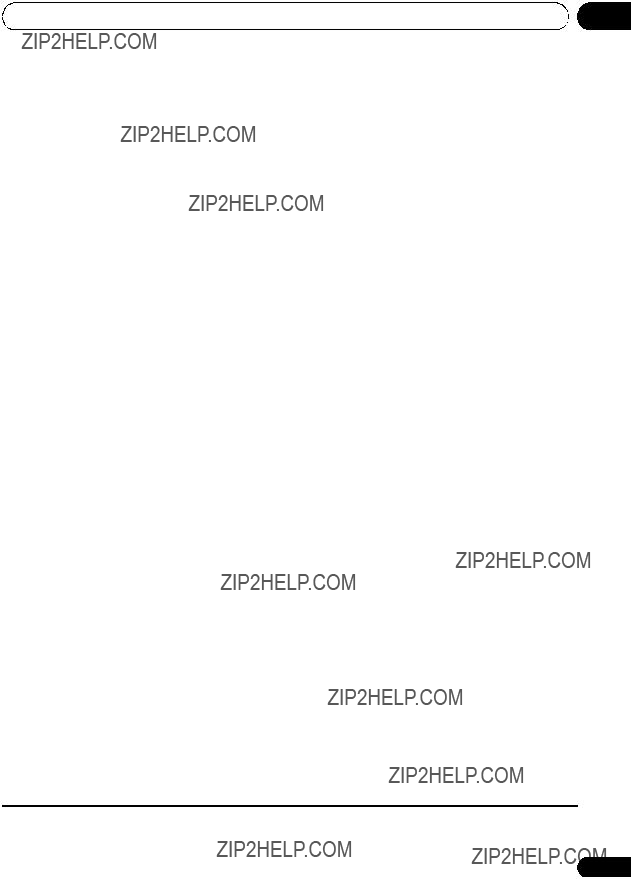
Display settings
Options settings
Parental Lock
???Default level: Off; Default password: none;
Default Country/Area code: us (2119)
To give you some control over what your children watch on your DVD player, some DVD- Video discs feature a Parental Lock level. If your player is set to a lower level than the disc, the disc won???t play.
Some discs also support the Country/Area Code feature. The player does not play certain scenes on these discs, depending on the Country/Area Code you set.
Registering a new password
Register a password to change the Parental Lock level or enter a Country/Area code.1
 Note
Note
1??? Not all discs use Parental Lock, and will play without requiring the password first.
??? If you forget your password, you???ll need to reset the player to register a new password (see Resetting the system on page 51).
43
En
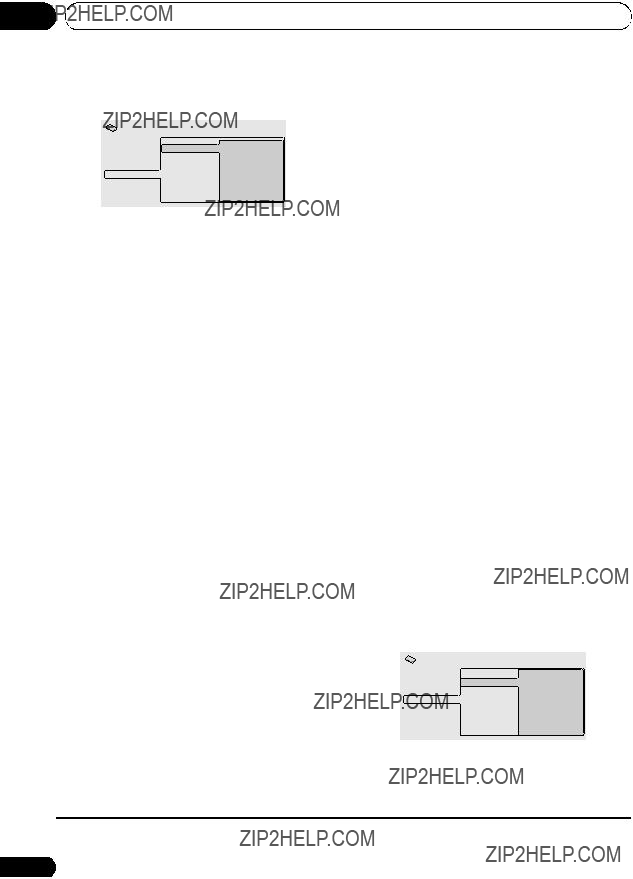
12 Initial Settings menu
1 Select ???Password???.
2 Use the number buttons to input a
Changing your password
To change your password, confirm your existing password then enter a new one.
1Select ???Password Change???.
2Input your existing password, then press
ENTER.
3Enter a new password and press ENTER.
Setting/changing the Parental Lock
1Select ???Level Change???.
2Use number buttons to enter your password, then press ENTER.
3Select a new level and press ENTER.
???Press ??? repeatedly to lock more levels
(more discs will require the password); press ??? to unlock levels. You can???t lock level 1.
Setting/changing the Country/Area code
You can find the Country/Area code list on page 56.
1Select ???Country Code???.
2Input your password, then press ENTER.
3Select a Country/Area code then press
ENTER.
There are two ways you can do this:
???Select by code letter: Use ???/??? to change the Country/Area code.
???Select by code number: Press ??? then use the number buttons to enter the
The new Country/Area code takes effect after ejecting the disc once.
About DivX?? VOD content
In order to play DivX VOD (video on demand) content on this player, you first need to register the player with your DivX VOD content provider. You do this by generating a DivX VOD registration code, which you submit to your
provider.1
 Important
Important
???DivX VOD content is protected by a DRM (Digital Rights Management) system. This restricts playback of content to specific, registered devices.
???If you load a disc that contains DivX VOD content not authorized for your player, the message Authorization Error is displayed and the content will not play.
Displaying your DivX VOD registration code
1Press HOME MENU and select ???Initial Settings???.
2Select ???Options???, then ???DivX(R) VOD???.
3 Select ???Display???.
Your
 Note
Note
1 Resetting the player (as described in Resetting the system on page 51) will not cause you to lose your registration code.
44
En

Make a note of the code as you will need it when you register with a DivX VOD provider.
Playing DivX?? VOD content
Some DivX VOD content may only be playable a fixed number of times. When you load a disc containing this type of DivX VOD content, the remaining number of plays is shown
If your DivX VOD content allows an unlimited number of plays, then you may load the disc into your player and play the content as often as you like, and no message will be displayed.
Speaker Distance
CX505/CX500 model only
??? Default setting: 3.0m
To get the best surround sound from your system, you should set up the speakers equal distances from your listening position.
1Press HOME MENU and select ???Initial Settings???.
2Select ???Speakers???, then ???Speaker
Distance???.
3 Use ???/??? to select a speaker.
4Press ??? to change the speaker distance for the highlighted speaker.
5Use ???/??? to change the distance.
???When you change the distance settings of the front left (L) or front right (R) speakers, all the other speaker distances change relative to it.
???Front left/right (L/R) speaker distances can be set from 30 cm to 9 m in 30 cm increments.1
???The center speaker (C) can be set from
???Surround left/right (SL/SR) speakers can be set from
???The subwoofer (SW) can be set from
6Press ??? to go back to the speaker list if you want to modify another speaker, or press ENTER to exit the Speaker Distance screen.
 Note
Note
1 The L and R speakers are paired; you can???t set them differently.
2 Make sure to set them the same distance when using Front Surround (Using Front Surround on page 27).
45
En

13 Additional information
Chapter 13
Additional information
Optional system settings
These settings are accessed by using the System Setup menu while in standby.
1Switch the system into standby.
2Press SYSTEM SETUP.
3Use ???/??? to choose the setting then press ENTER.
The current setting is shown for each option as you cycle through the display. See below for a full list and description of each.
4Use ???/??? to adjust the setting then press
ENTER to confirm.
5Repeat steps 2 to 4 to make other settings.
TV system setting
The default setting of this system is AUTO, and unless you notice that the picture is distorted when playing some discs, you should leave it set to AUTO. If you find picture distortion with some discs, set the TV system to match your country or region???s system. However, this may restrict the kinds of disc you can watch.
See the table for the kinds of discs compatible with each setting (AUTO, PAL and NTSC).1
??? After selecting TV SYS in step 3 above, press ENTER to change the TV system.
The TV system as follows:
???AUTO ??? NTSC
???NTSC ??? PAL
???PAL ??? AUTO
System Setup menu options in standby
Below are all the available settings in the setup menu. The first setting in each is the default.
System demo setting
Switches the automatic demo feature on or off (this starts when you plug in for the first time):
???DEMO ON ??? Switches the demo feature on.
???DEMO OFF ??? Switches the demo feature off.
Frequency step setting
If you find that you can???t tune into stations successfully, the frequency step may not be suitable for your country/region.
???AM 9K ??? AM 9 kHz/FM 50 kHz
???AM 10K ??? AM 10 kHz/FM 100 kHz
The system automatically switches on and you???ll see the new TV system setting in the display after seeing WELCOME.2
 Note
Note
1 Most models of the newly developed countdown PAL TV system detect 50 Hz (PAL)/60 Hz (NTSC) and automatically switch vertical amplitude, resulting in a display without vertical shrinkage. However, in some cases, the image may appear without color. If your PAL TV does not have a
2 You have to switch the player into standby (press ??? STANDBY/ON) before each change.
46
En
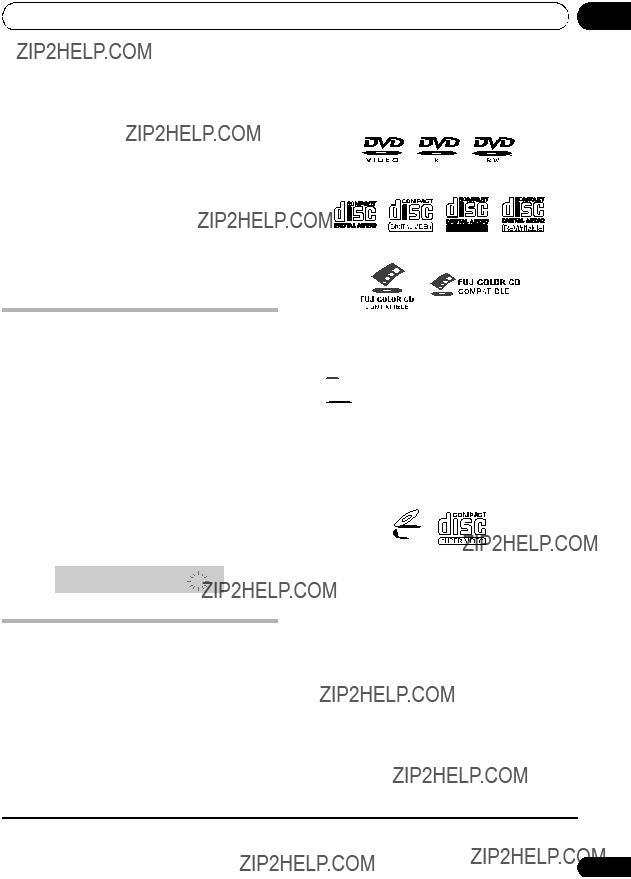
Key lock setting
???LOCK ON ??? Makes the front panel buttons and controls inoperative.
???LOCK OFF ??? Restores regular use of the front panel buttons and controls.
See the About DualDisc playback below for more information.
Volume mode setting
If you want to make finer adjustments of the volume.
???FINE ??? 60 steps
???NORMAL ??? 30 steps
Setting the sleep timer
The sleep timer switches off the system after about an hour so you can fall asleep without
worrying about it.1
??? Press SLEEP repeatedly to select an option.
Choose between the following options:
???SLP ON ??? Switches off after about an hour
???SLP OFF ??? Cancels the sleep timer
After selecting SLP ON, you can press SLEEP again to check how much time is left. Each line indicates approximately 12 minutes (remaining):
Fujicolor CD
???This unit will play DVD+R/+RW discs.
??? is a trademark of FUJIFILM Corporation.
is a trademark of FUJIFILM Corporation.
??? is a trademark of DVD Format/Logo Licensing Corporation.
is a trademark of DVD Format/Logo Licensing Corporation.
???Also compatible with KODAK Picture CD.
This player supports the IEC???s Super VCD standard for superior picture quality, dual soundtracks, and widescreen support.
VIDEO

 CD
CD
Super Video CD (Super VCD)
S L P - - - - -
Disc/content format playback compatibility
This player is compatible with a wide range of disc types (media) and formats. Playable discs will generally feature one of the following logos on the disc and/or disc packaging. Note however that some disc types, such as recordable CD and DVD, may be in an unplayable format.
About DualDisc playback
A DualDisc is a new two
The
The DVD side of a DualDisc plays in this product.
For more detailed information on the DualDisc specification, please refer to the disc manufacturer or disc retailer.
 Note
Note
1 The Front panel display dims when the sleep timer is set and the sleep indicator turns on.
47
En

13 Additional information
Disc compatibility table
9660
* ISO 9660 Level 1 or 2 compliant. CD physical format: Mode1, Mode2 XA Form1. Romeo and Joliet file systems are both compatible.
???
???Unfinalized disc playback: No
???Multi Border playback: No
???Unfinalized playback: No
software used to create the disc. In these instances, check the
??? Discs recorded in packet write mode are not compatible.
JPEG file ??? Baseline JPEG and EXIF 2.2* still image files up to a resolution of 3072 x 2048.
*File format for digital still cameras
???Progressive JPEG compatible: No
???File extensions: .jpg (must be used for the player to recognize JPEG files)
???File structure (may differ): Up to 299 folders on a disc; up to 648 folders and files (combined) within each folder
About DVD+R/DVD+RW compatibility
Only DVD+R/DVD+RW discs recorded in ???Video Mode (DVD Video Mode)??? which have been finalized, can be played back. However, some editing made during the recording may not be played back accurately.
About DivX
Compressed ???
audio Windows Media Audio (WMA), MPEG- 4 AAC
???Sampling rates: 32 kHz/44.1 kHz/ 48 kHz
???
???VBR (variable bit rate) MP3/WMA/
???WMA lossless encoding: No
???DRM (Digital Rights Management) compatible: Yes
???File extensions: .mp3, .wma, .m4a (these must be used for the player to recognize
???File structure (may differ): Up to 299 folders on a disc; up to 648 folders and files (combined) within each folder
DivX is a compressed digital video format
created by the DivX?? video codec from DivX, Inc. This player can play DivX video files burned on
DivX video compatibility
???Official DivX?? Certified product.
???Plays all versions of DivX?? video (including DivX??6) with standard playback of DivX?? media files.1
 Note
Note
1 Playback of .avi video files larger than 4 GB is not possible.
48
En
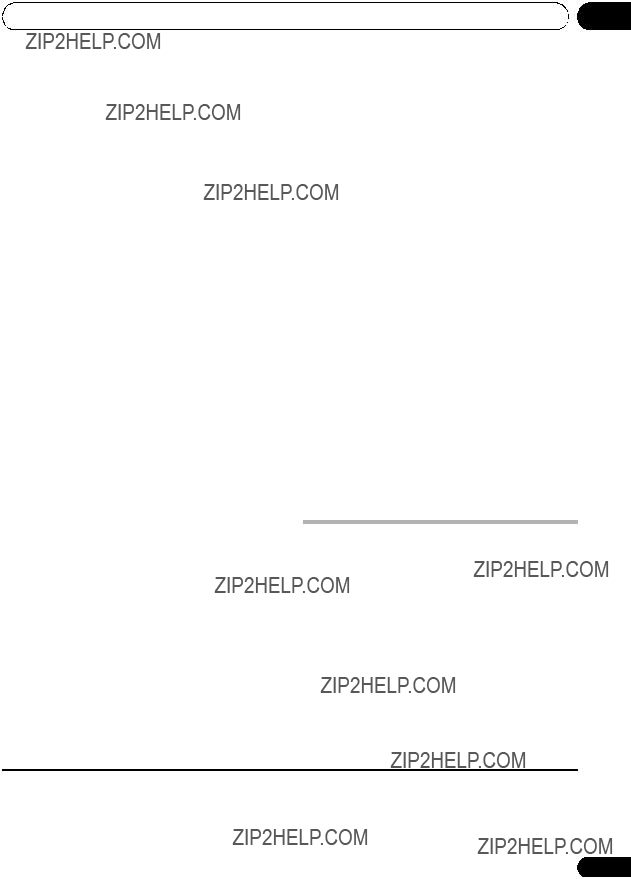
???File extensions: .avi and .divx (these must be used for the player to recognize DivX video files). Note that all files with the .avi extension are recognized as MPEG4, but not all of these are necessarily DivX video files and therefore may not be playable on this player.
extension ???.m4a???.
iTunes?? may not play, or filenames may display incorrectly.
Apple and iTunes are trademarks of Apple Inc., registered in the U.S. and other countries.
Displaying DivX subtitle files
The font sets listed below are available for DivX external subtitle files. You can see the proper font set
Language (in Language settings on page 42)
to match the subtitle file.1
Group 1: Albanian (sq), Basque (eu), Catalan (ca), Danish (da), Dutch (nl), English (en), Faroese (fo), Finnish (fi), French (fr), German (de), Icelandic (is), Irish (ga), Italian (it), Norwegian (no), Portuguese (pt),
Group 2: Albanian (sq), Croatian (hr), Czech (cs), Hungarian (hu), Polish (pl), Romanian (ro), Slovak (sk), Slovenian (sl)
Group 3: Bulgarian (bg), Byelorussian (be), Macedonian (mk), Russian (ru), Serbian (sr), Ukrainian (uk)
Group 4: Hebrew (iw), Yiddish (ji)
Group 5: Turkish (tr)
DivX, DivX Certified, and associated logos are trademarks of DivX, Inc. and are used under license.
About
Advanced Audio Coding (AAC) is at the core of the
back AAC files encoded by iTunes?? bearing the
About WMA
This player can playback Windows Media Audio content.
WMA is an acronym for Windows Media Audio and refers to an audio compression technology developed by Microsoft Corporation. WMA content can be encoded by using Windows
Media?? Player version 7.7.1, Windows Media??
Player for Windows?? XP, or Windows Media?? Player 9 series.
Windows Media is either a registered trademark or trademark of Microsoft Corporation in the United States and/or other countries.
This product includes technology owned by Microsoft Corporation and cannot be used or distributed without a license from Microsoft Licensing, Inc.
Using and taking care of discs
DVD Video regions
All DVD Video discs carry a region mark that indicates which region(s) of the world the disc is compatible with. Your DVD system also has a region mark (on the rear panel). Discs from incompatible regions will not play in this player. Discs marked ALL play in any player.
 Note
Note
1 ??? For external subtitle files the following subtitle format filename extensions are supported (please note that these files are not shown within the disc navigation menu): .srt, .sub, .ssa, .smi
???Some external subtitle files may be displayed incorrectly or not at all.
???The filename of the movie file has to be repeated at the beginning of the filename for the external subtitle file.
???The number of external subtitle files which can be switched for the same movie file is limited to a maximum of 10.
49
En

13 Additional information
Handling discs
Hold the disc by its edges when handling so as not to leave fingerprints, dirt or scratches on either side of the disc. Damaged or dirty discs can affect playback performance.
If a disc becomes marked with fingerprints, dust, etc., clean using a soft, dry cloth.
Wipe lightly from the center of the disc using straight strokes. Don???t wipe the disc surface with circular strokes.
If necessary, use a cloth soaked in alcohol, or a commercially available CD/DVD cleaning kit to clean a disc more thoroughly. Never use benzine, thinner or other cleaning agents such as those designed for cleaning vinyl records.
Storing discs
Avoid leaving discs in excessively cold, humid, or hot environments (including under direct sunlight). Don???t glue paper or put stickers onto the disc, or use a pencil,
Discs to avoid
Discs spin at high speed inside the player. If a disc is cracked, chipped, warped, or otherwise damaged, don???t risk using it in your player ??? you could end up damaging the unit.
This unit is designed for use with conventional, fully circular discs only. Pioneer disclaims all liability arising in connection with the use of shaped discs.
Installation and maintenance
Hints on installation
We want you to enjoy using this system for years to come, so please bear in mind the following points when choosing a location:
Do...
???Use in a
???Place on a solid, flat, level surface, such as a table, shelf or stereo rack.
Don???t...
???Use in a place exposed to high temperatures or humidity, including near radiators and other
???Place on a window sill or other place where the system will be exposed to direct sunlight.
???Use in an excessively dusty or damp environment.
???Place directly on top of an amplifier, or other component in your stereo system that becomes hot in use.
???Use near a television or monitor as you may experience interference ??? especially if the television uses an indoor antenna.
???Use in a kitchen or other room where the system may be exposed to smoke or steam.
???Use on a thick rug or carpet, or cover with cloth
??? this may prevent proper cooling of the system unit.
???Place on an unstable surface, or one that is not large enough to support all four of the system unit???s feet.
Cleaning the pickup lens
The DVD player???s lens should not become dirty in normal use, but if for some reason it should malfunction due to dust or dirt, consult your nearest Pioneer authorized service center. Although lens cleaners are commercially available, we do not recommend using them since some may damage the lens.
50
En

Additional information
Problems with condensation
Condensation may form inside the player if it is brought into a warm room from outside, or if the temperature of the room rises quickly. Although this won???t damage the player, it may temporarily impair performance. You should leave it to adjust to the warmer temperature for about an hour before switching on.
Moving the system unit
If you need to move the main unit, first remove a disc if there???s one in the player, then press  STANDBY/ON on the front panel to turn the system off. Wait for GOOD BYE to disappear from the display, then unplug the power
STANDBY/ON on the front panel to turn the system off. Wait for GOOD BYE to disappear from the display, then unplug the power
cord.1 Never lift or move the unit during playback ??? discs rotate at high speeds and may be damaged.
13
Resetting the system
Use this procedure to reset all system settings to the factory default. Use the front panel controls to do this.
1Switch the system on.
2Press the DVD/CD button and select DVD.
Make sure the disc tray is empty.
3Press and hold the ??? button for about eight seconds until the display shows ???MEM CLR????.
4Press the ??? button.
MEM CLR will be displayed in the front panel display and the player switches into standby.
5 Press the  STANDBY/ON.
STANDBY/ON.
All the system???s settings are now reset.
Screen sizes and disc formats
movies2, with an aspect ratio of up to about 7:3.
Televisions also come in different aspect ratios; ???standard??? 4:3 and widescreen 16:9.3
Set to 4:3 (Letter Box), widescreen discs are shown with black bars top and bottom.
Set to 4:3 (Pan&Scan), widescreen discs are shown with the left and right sides cropped. Although the picture looks larger, you don???t actually see the whole picture.
 Note
Note
1 Unplugging the unit before GOOD BYE disappears from the display may cause the system to return to the factory settings. 2 Many widescreen discs override the system???s settings so that the disc is shown in letterbox format regardless of the setting.
3??? Using the 16:9 (Wide) setting with a standard 4:3 TV, or one of the 4:3 settings with a widescreen TV, will result in distortion.
???When you watch discs recorded in 4:3 format, you can use the TV controls to select how the picture is presented. Your TV may offer various zoom and stretch options; see the instructions that came with your TV for details.
???Some movie aspect ratios are wider than 16:9, so even with a widescreen TV, these discs will still play in a ???letterbox??? style.
51
En
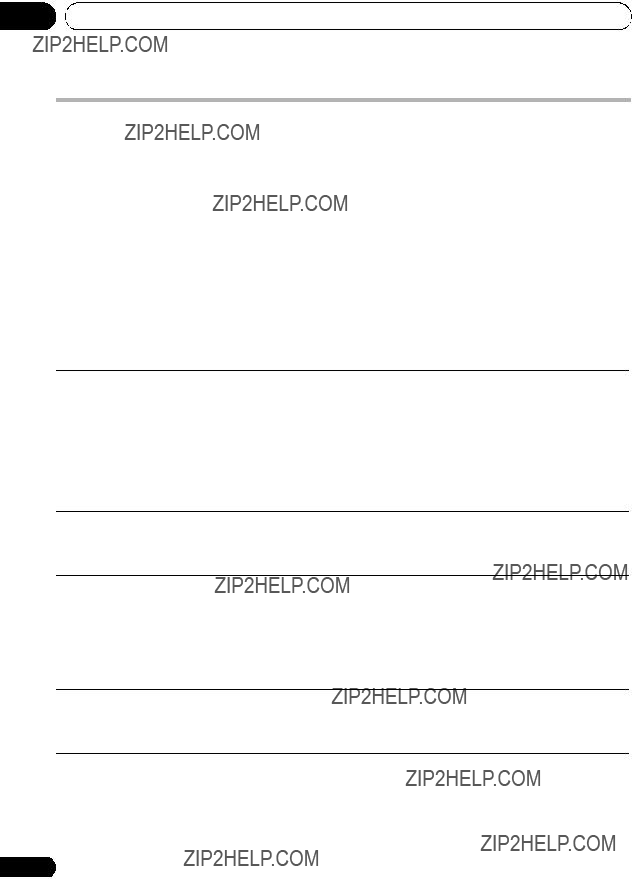
13 Additional information
Troubleshooting
Incorrect operations are often mistaken for trouble and malfunctions. If you think that there is something wrong with this component, check the points below. Sometimes the trouble may lie in another component. Investigate the other components and electrical appliances being used. If the trouble cannot be rectified even after exercising the checks listed below, ask your nearest Pioneer authorized service center or your dealer to carry out repair work.
???If the unit does not operate normally due to external effects such as static electricity disconnect the power plug from the outlet and insert again to return to normal operating conditions.
General
The power does not turn on.
???Connect the power plug to the wall outlet.
???Disconnect the power plug from the outlet, and insert again.
???Make sure the power source is the right voltage for the AC inlet.
The power does not turn on, or switches off suddenly (an error message may be displayed at startup).
???Wait for one minute before switching back on.
???Make sure there are no loose strands of wire touching the unit. This could cause the system to shut off automatically.
???Check that the speakers are connected correctly.
???Make sure the voltage of the mains power source is correct for the model.
???Try reducing the volume level.
???If the problem persists, take it to your nearest Pioneer authorized service center or your dealer for servicing.
No sound is output when a function is selected.
???If you???re using the F.AUDIO/LINE input, make sure the component is connected correctly (see Connecting auxiliary components on page 15).
???Press MUTE on the remote control to turn muting off.
???Adjust the volume.
The microphone can???t be heard. ??? You are only using one microphone and it???s plugged into the MIC (SUB) jack. The MIC (SUB) jack can only be used if there is also a microphone plugged into the MIC (MAIN) jack.
??? Adjust the MIC VOL.
52
En

DVD/CD/Video CD player
53
En

13 Additional information
Tuner
USB connection
54
En

Error Messages
Using the language code list
Some of the language options (see Language settings on page 42) allow you to set your preferred language from any of the 136 languages listed in the Language code list.
1Switch the system on.
2Press the DVD/CD button and select DVD.
Make sure the disc tray is empty.
3Use ???/??? to select either a code letter or a code number.
4Use ???/??? to select a code letter or a code number.
See the Language code list below for a complete list of languages and codes.
55
En

13 Additional information
Language code list
Language (Language code letter), Language code
Country/Area code list
Country/Area, Country/Area code, Country/Area code letter
56
En

Additional information
Specifications
??? Amplifier section
CX505/CX500 model
Continuous power output:
Front . . . . . . . . . . . . . . . . . . . . 100 W per channel (1 kHz, 10 % T.H.D., 4 ??)
Center . . . . . . . . 100 W (1 kHz, 10 % T.H.D., 4 ??) Surround . . . . . . . . . . . . . . . . 100 W per channel (1 kHz, 10 % T.H.D., 4 ??)
Subwoofer . . . 100 W (100 Hz, 10 % T.H.D., 4 ??)
CX303 model
Front . . . . . . . . . . . . . . . . . . . . 100 W per channel (1 kHz, 10 % T.H.D., 4 ??)
Subwoofer . . . 100 W (100 Hz, 10 % T.H.D., 4 ??)
???Disc section
Digital audio characteristics
. . . . . . . . . . . . . . . . . . . . . . .DVD fs: 96 kHz,
???FM tuner section
Frequency range . . . . . . . . 87.5 MHz to 108 MHz Antenna . . . . . . . . . . . . . . . . . . 75 ??, unbalanced
??? AM tuner section
Frequency range:
With 9 kHz step . . . . . . . . 531 kHz to 1602 kHz With 10 kHz step . . . . . . . 530 kHz to 1700 kHz Antenna . . . . . . . . . . . . . . . . . . . . . Loop antenna
??? Miscellaneous
Power requirements
Australia, New Zealand model
. . . . . . . . . . . . . . . . . . . . AC 240 V, 50 Hz/60 Hz Singapore, Malaysia, Indonesia, Philipines, Argentine model
. . . . . . . . . . . . . AC 220 V to 240 V, 50 Hz/60 Hz Taiwanese model . . . . . AC 110 V, 50 Hz/60 Hz
Power consumption:
CX505/CX500 model . . . . . . . . . . . . . . . . .66 W
13
CX303 model . . . . . . . . . . . . . . . . . . . . . . . 43 W Power consumption in standby mode . . . . 0.5 W Dimensions:
DVD/CD Receiver
. . . . . . 210 mm (W) x 112 mm (H) x 336 mm (D) Power unit
. . . . . . . 197 mm (W) x 65 mm (H) x 162 mm (D) Weight:
DVD/CD Receiver:
CX505/CX500 model . . . . . . . . . . . . . . . . 2.9 kg CX303 model . . . . . . . . . . . . . . . . . . . . . . 2.8 kg Power unit . . . . . . . . . . . . . . . . . . . . . . . . . . 1.1 kg
???Accessories (DVD/CD receiver)
Remote control . . . . . . . . . . . . . . . . . . . . . . . . . . 1 Power cord:
Duty free model . . . . . . . . . . . . . . . . . . . . . . . 2 Argentine (CX303 only), Taiwan,
Philippines models. . . . . . . . . . . . . . . . . . . . . 2 All other models . . . . . . . . . . . . . . . . . . . . . . . 1
Power plug adapter (CX303 Argentine model only) . . . . . . . . . . . . . . . . . . . . . . . . . . . . . . . . . . . 1 Video cord . . . . . . . . . . . . . . . . . . . . . . . . . . . . . . 1 AM loop antenna . . . . . . . . . . . . . . . . . . . . . . . . 1 FM antenna . . . . . . . . . . . . . . . . . . . . . . . . . . . . 1 AA/R6 dry cell batteries
(to confirm system operation) . . . . . . . . . . . . . . 2 These operating instructions
???Front speakers
Enclosure . . . . . . . . .
System . . . . . . . . . . . . . . . . . 10 cm
Woofer . . . . . . . . . . . . . . . . . . .10 cm cone type Tweeter . . . . . . . . . . . . 2.6 cm
Dimensions
. . . . . . 130 mm (W) x 221 mm (H) x 172 mm (D) Weight . . . . . . . . . . . . . . . . . . . . . . . . . . . . . 1.7 kg
???Subwoofer
Enclosure . . . . . .
System . . . . . . . . . . . . . . . . . 14 cm
57
En

13 Additional information
Speaker . . . . . . . . . . . . . . . . 14 cm cone type x 2 Nominal impedance . . . . . . . . . . . . . . . . . . . .4 ?? Frequency range . . . . . . . . . . . . .32 Hz to 6 kHz Maximum input power . . . . . . . . . . . . . . . 100 W Dimensions
. . . . . 190 mm (W) x 444 mm (H) x 220 mm (D) Weight . . . . . . . . . . . . . . . . . . . . . . . . . . . . . 5.7 kg
???Accessories
???Front speakers
Same as
???Center speaker
Enclosure. . . . . . . . . .
System . . . . . . . . . . . . . . . . . 7.7 cm
. . . . . . 200 mm (W) x 108 mm (H) x 101 mm (D) Weight . . . . . . . . . . . . . . . . . . . . . . . . . . . . 0.75 kg
???Surround speakers
Enclosure. . . . . . . . . .
System . . . . . . . . . . . . . . . . . 7.7 cm
. . . . . . 130 mm (W) x 100 mm (H) x 110 mm (D) Weight . . . . . . . . . . . . . . . . . . . . . . . . . . . . 0.68 kg
???Subwoofer
Same as
???Accessories
speakers . . . . . . . . . . . . . . . . . . . . . . . . . . . . . . 16
58
???Front speakers
Enclosure . . . . . . . . . .
System . . . . . . . . . . . . . . . . 7.7 cm
. . . . . . .100 mm (W) x 100 mm (H) x 103 mm (D) Weight. . . . . . . . . . . . . . . . . . . . . . . . . . . . . 0.55 kg
???Center speaker
Enclosure . . . . . . . . . .
System . . . . . . . . . . . . . . . . 7.7 cm
. . . . . . .100 mm (W) x 100 mm (H) x 103 mm (D) Weight. . . . . . . . . . . . . . . . . . . . . . . . . . . . . 0.55 kg
???Surround speakers
Enclosure . . . . . . . . . .
System . . . . . . . . . . . . . . . . 7.7 cm
. . . . . . .100 mm (W) x 100 mm (H) x 103 mm (D) Weight. . . . . . . . . . . . . . . . . . . . . . . . . . . . . 0.55 kg
???Subwoofer
Same as
???Accessories
Speaker cables . . . . . . . . . . . . . . . . . . . . . . . . . . 5 Brackets . . . . . . . . . . . . . . . . . . . . . . . . . . . . . . . . 2 Screws . . . . . . . . . . . . . . . . . . . . . . . . . . . . . . . . . 8 Spiral wrap . . . . . . . . . . . . . . . . . . . . . . . . . . . . . 2
En

 Note
Note
???Specifications and design subject to possible modification without notice, due to improvements.
This product includes FontAvenue?? fonts licenced by NEC corporation. FontAvenue is a registered trademark of NEC Corporation.
This product incorporates copyright protection technology that is protected by method claims of certain U.S. patents and other intellectual property rights owned by Macrovision Corporation and other rights owners. Use of this copyright protection technology must be authorized by Macrovision Corporation, and is intended for home and other limited uses only unless otherwise authorized by Macrovision Corporation. Reverse engineering or disassembly is prohibited.
DRM (digital rights management) copy protection is a technology designed to prevent unauthorized copying by restricting playback, etc. of compressed audio files on devices other than the PC (or other recording equipment) used to record it. For detailed information, please see the instruction manuals or help files that came with your PC and/or software.
Manufactured under license from Dolby
Laboratories.???Dolby???, ???Pro Logic??? and the double-
D symbol are trademarks of Dolby Laboratories.
???DTS???, ???DTS Digital Surround??? and ???DTS 2.0??? are registered trademarks of DTS, Inc.
59
En

Published by Pioneer Corporation.
Copyright ?? 2007 Pioneer Corporation.
All rights reserved.
PIONEER CORPORATION
PIONEER ELECTRONICS (USA) INC.
P.O. BOX 1540, Long Beach, California
PIONEER ELECTRONICS OF CANADA, INC.
300 Allstate Parkway, Markham, Ontario L3R 0P2, Canada TEL:
PIONEER EUROPE NV
Haven 1087, Keetberglaan 1,
PIONEER ELECTRONICS ASIACENTRE PTE. LTD.
253 Alexandra Road,
PIONEER ELECTRONICS AUSTRALIA PTY. LTD.
PIONEER ELECTRONICS DE MEXICO S.A. DE C.V.
Blvd.Manuel Avila Camacho 138 10 piso Col.Lomas de Chapultepec, Mexico,D.F. 11000 TEL:
K002_B_En